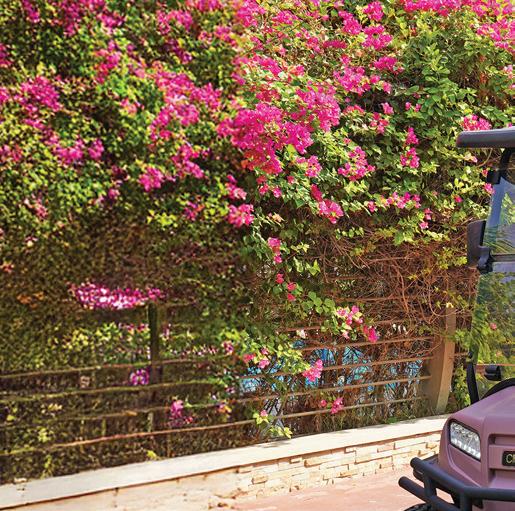

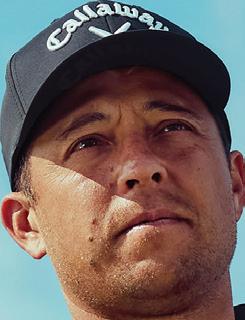










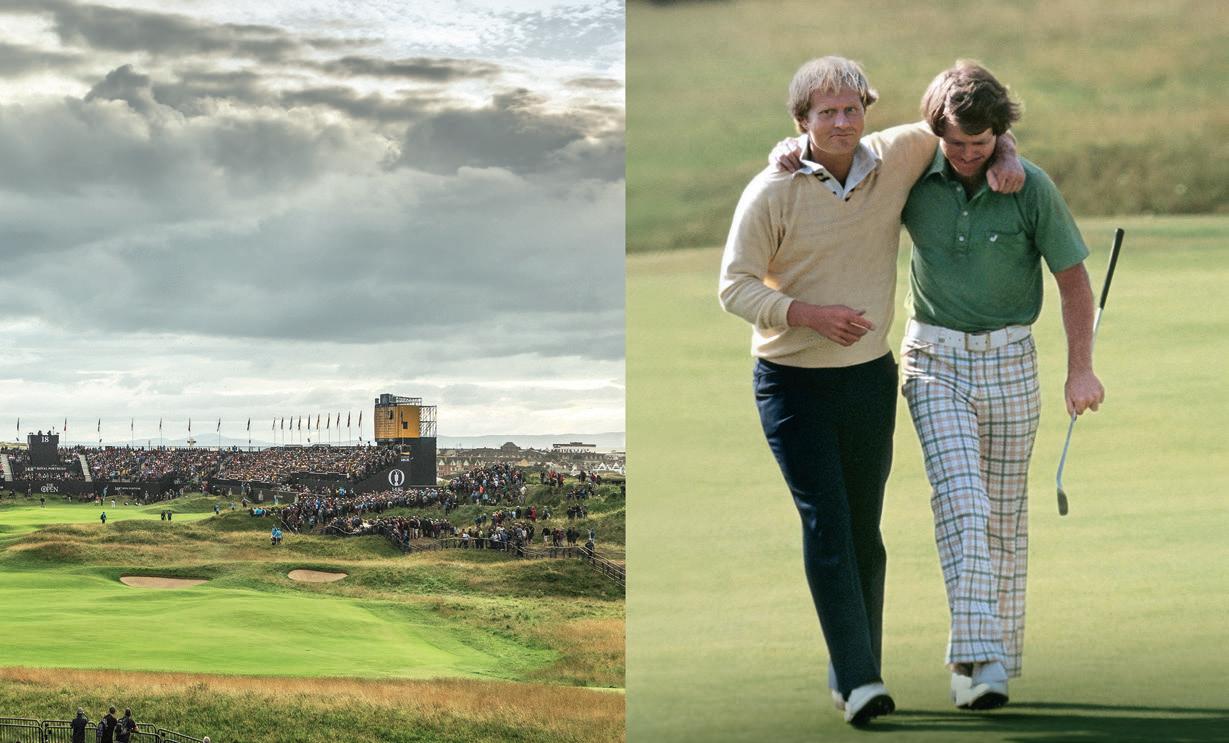

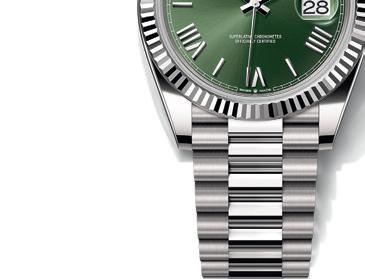




The Open Championship returns this July to Royal Portrush on Northern Ireland’s North Atlantic coast for just the third time in its history—the only Opens not played in England or Scotland. Read why Royal Portrush is unlike any other course in the Open rota on page 42.


56 Preparation Portrush Inside a coach’s build-up to The
26 Utility Irons
These clubs will be in abundance at Royal Portrush.
Make Links Golf Great Championship golf returns to the dunes at Trump International Scotland.
Get More
What I did to win my first two majors and how you can go on your own run.
58 Not His Peake Former gang member and convict Ryan Peake has qualified for the Open but wants to be known for more.
BY JOEL BEALL AND EVIN PRIEST
22 Chip It In I’m trying to hole every chip shot, and you should too. BY SHANE LOWRY
24 Swing Analysis How Ryder Cupper Nicolai Højgaard changed his backswing to gain distance.
BY DAVE ALLEN
BY PETER MORRICE
28 Time To Get Fit?
A clubfitting expert explains why timing is important.
BY MIKE STACHURA
29 Why Club-Fitting Matters
This is how eGolf Megastore is raising the bar for amateurs across the GCC.
BY HARRY GRIMSHAW
30 Your Questions Answered How to pick the right shafts for your game.
BY MIKE STACHURA, E. MICHAEL JOHNSON AND JONATHAN WALL
32 What’s In My Bag Christiaan Bezuidenhout WITH JONATHAN WALL where to play
34 Sunningdale’s Old Course Host to the 2025 ISPS HANDA Senior Open. BY HARRY GRIMSHAW
38 Exclusive Event The Dubai Creek International Pairs Tournament.
42 Royal Portrush Why the Northern Irish links is unique in the Open rota.
BY DEREK DUNCAN
66 Club News
A gallery of some of the local winners in the amateur circuit.


What do you give someone, who already has everything?
BY HARRY GRIMSHAW
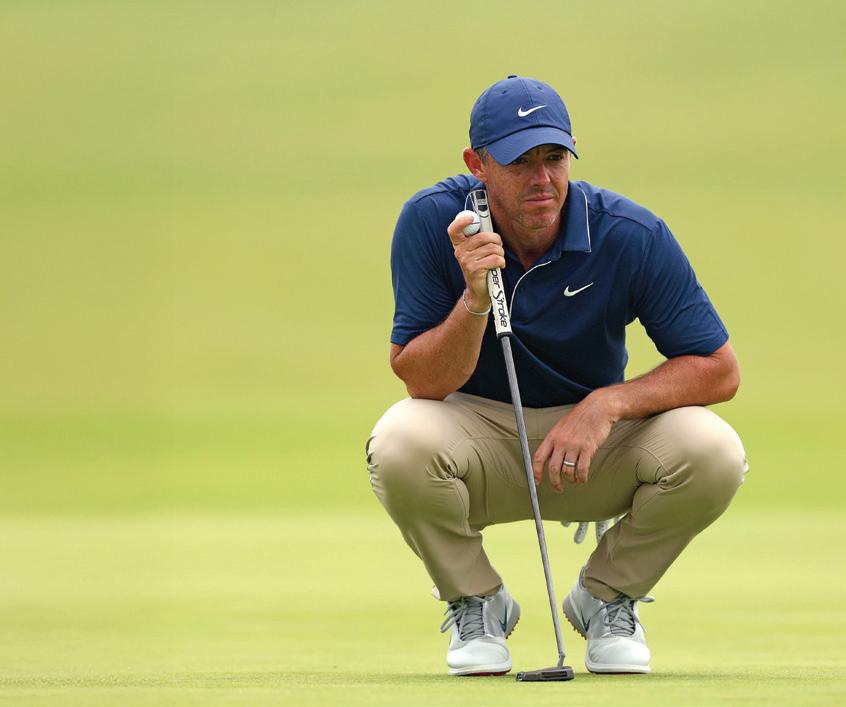
IT’S THE AGE-OLD QUESTION.
If golf were a video game, Rory McIlroy has completed it. With his Masters win in April, he finally conquered Augusta and joined the elite group of career Grand Slam winners. But ever since that historic Sunday, the question has become: what now?
Post-Masters, things have been a little… off. Not disastrous, but not quite right either. Since slipping on the green jacket, Rory’s form has been mixed — T7, T47, MC, T19, and a T6. Two top 10s in five starts isn’t bad, but by his standards, it’s not quite firing.
More noticeable, though, has been a shift in his mood. The ever-candid, media-friendly Rory has shown flashes of frustration. His answers have been shorter. Pressers, sometimes testy. Much of that boiled over when it was leaked that his TaylorMade driver had failed a conformity test at the PGA Championship — a routine occurrence in pro golf, but still a headline-maker given the timing and the player involved.
Fans and media can sense something’s off — with his patience, maybe even with his focus. After all, when you finally reach the summit you’ve been climbing for a decade, it’s only natural to look around and wonder what’s left.
Well, how about this: an Open Championship at home.
“If I can’t get motivated for an Open at Portrush, then I don’t know what can,”
McIlroy said. “I climbed my Everest in April, and now I need another mountain. An Open at Portrush is certainly one of those.”
He’ll have a few weeks to reset before teeing it up in front of a record-breaking number of fans with a euphoric Northern Irish crowd. It’ll be his first time back home in the publiceye since winning the Masters, and the atmosphere will be electric at Royal Portrush.
“As I said, I just need to get myself in the right frame of mind. I probably haven’t been there the last few weeks.
“Getting home and having a couple weeks off before that, hopefully feeling refreshed and rejuvenated, will get me in the right place again.
“Hopefully I can celebrate with them [home fans] on Sunday night with the Claret Jug and the Green Jacket.”
That would be some homecoming — and maybe, the start of Rory’s next chapter.







editor-in-chief Obaid Humaid Al Tayer
managing partner & group editor
Ian Fairservice
chief commercial officer
Anthony Milne
editor Harry Grimshaw
art director Clarkwin Cruz
editorial assistant Londresa Flores
publisher David Burke
general manager - production
S. Sunil Kumar
production manager Binu Purandaran
assistant production manager
Venita Pinto
THE GOLF DIGEST PUBLICATIONS
editor-in-chief Jerry Tarde
senior director, business development & partnerships
Greg Chatzinoff
international editor Ju Kuang Tan
GOLF DIGEST USA
editor-in-chief Jerry Tarde
general manager Chris Reynolds
editorial director Max Adler
executive editor Peter Morrice
art director Bill Specht
managing editors Alan P. Pittman, Ryan Herrington
playing editors Collin Morikawa, Jordan Spieth, Bubba Watson
head office
Media One Tower, PO Box 2331, Dubai, UAE Tel: +971 4 427 3000; Fax: +971 4 428 2266
dubai media city
SD 2-94, 2nd Floor, Building 2, Dubai, UAE
Tel: +971 4 390 3550; Fax +971 4 390 4845
Email: motivate@motivate.ae
abu dhabi
14th Floor, Office 1406, Makeen Tower, 9th Street, Al Zahiyah, PO Box 43072, Abu Dhabi, UAE Tel: +971 2 677 2005; Fax: +971 2 657 3401
Email: motivate-adh@motivate.ae
saudi arabia
Regus Offices No. 455 - 456, 4th Floor, Hamad Tower, King Fahad Road, Al Olaya, Riyadh, KSA
Tel: +966 11 834 3595 / +966 11 834 3596
Email: motivate@motivate.ae
london
Motivate Publishing Ltd, Acre House, 11/15 William Road, London, NW1 3ER, UK
Email: motivateuk@motivate.ae
Golf Digest and How to play, what to play, where to play are registered trademarks of Warner Bros. Discovery. Copyright © 2024 Discovery Golf Inc. All rights reserved. Printed in the U.S.A. Published by Warner Bros. Discovery. Principal office: Golf Digest, 230 Park Avenue South, New York, NY, 10003. Warner Bros/Discovery Luis Silberwasser, Chairman & CEO TNT Sports; Gunnar Wiedenfels, Chief Financial Officer. Periodicals postage paid at New York, N.Y., and at additional mailing offices.

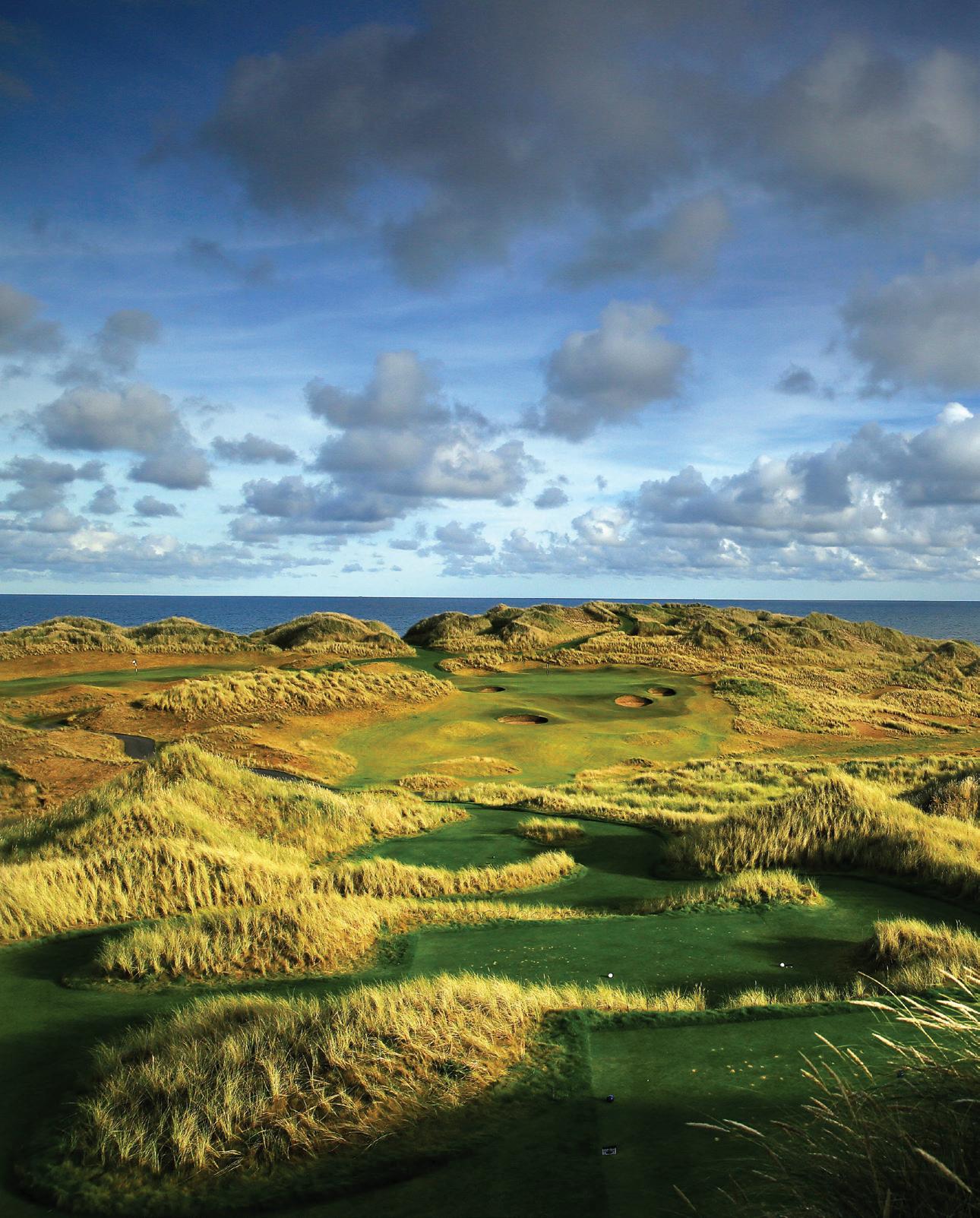


Championship golf returns to the dunes at Trump International Scotland


SET AGAINST THE DRAMATIC BACKDROP of Scotland’s northeast coast, Trump International Golf Links winds through the towering dunes of Aberdeenshire.
Designed by renowned architect Dr. Martin Hawtree, the Old course is an 18-hole, par-72 Championship course that stretches to 6,921 yards and offers a pure links experience shaped entirely by the natural landscape.
With sweeping sea views and challenging terrain, it’s set to host back-to-back big events this summer: the Staysure PGA Seniors Championship and the inaugural Scottish Championship on the DP World Tour.
The Trump Organisation owns more than 18 golf courses globally, including one in Dubai, United Arab Emirates, and have recently announced upcoming sites in Qatar and Oman located in the Middle East.





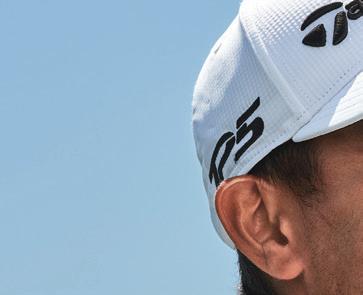



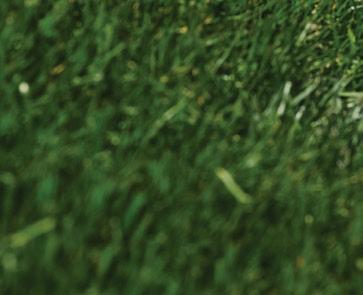








AGE: 25
FROM: PERTH, AUSTRALIA
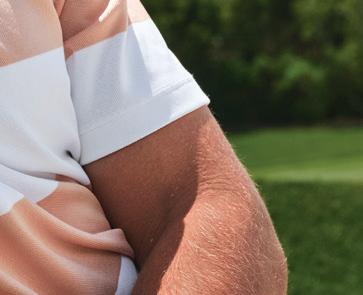
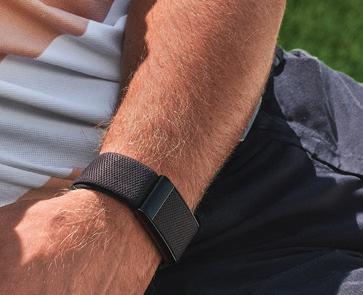




WITH KEELY LEVINS
THE OTHER DAY I WAS THROWING AWAY A GOLF BALL BOX, and I had a flashback to being 6 and digging through the golf course’s trash to find those boxes. I needed them for the balls my dad and I found and sold to the local country club. We once bartered 3,000 used golf balls for a set of junior clubs. It took two years, but we did it.
My parents divorced when I was a baby. My dad and I lived off his pension from a career as a migration agent. He was a scratch golfer. He saw my talent and dedicated his life to my golf. I had a really active mind as a kid. On the golf course, I could focus that mental energy into the next shot. My dad coached me and started a YouTube channel to raise money with the goal of playing in the U.S. Kids World Championships in Pinehurst. The second time I went, I won my age group.
●
●
●
People started to notice. We moved around Australia accepting various offers for course access and housing. Our finances were thin. When I was 14, we got the ultimate offer. I accepted an opportunity to train in the U.S. I missed my dad, but I was young and obsessed with the game, loving being able to play and practice as much as I wanted. Soon, living far from home wasn’t hard for me. It wasn’t until I was older and winning bigger tournaments that I started to think, Man, Dad should be here seeing this.
●
When I was 15, I won the Southern Amateur and gold at the Youth Olympics . I committed to Stanford University. Tiger Woods was my idol.
● ●
●
College golf was a wake-up. You think you’re playing well shooting 75 on a hard golf course, but the other guy is carding the easiest 69. You think, How did he do that? I started working with Colin Swatton and still work with him. We focused on consistency. Then something clicked. I went from a stack-andtilt swing to turning my sternum a bit
more into my right side and setting the club with a little more wrist hinge.
● ● ●
On the final hole of NCAAs, I hit a bad drive and made bogey. I slipped from No. 6 in the PGA Tour U rankings to No. 10. That cost me Korn Ferry status, though I got PGA Tour Latino Americas starts. After graduation, I played a couple of events but knew it wasn’t the right style of golf for me. I’m more of a bomb and gouger. It was a gamble, but I came back to the U.S. and played Korn Ferry Monday qualifiers.
● ● ●
I missed the first week. The next, I got a sponsor’s invite into a qualifier that was only 12 guys for one spot, instead of the usual 80 for four. I won it and finished in the top 15. That got me into the next week—another top 15. In my third event, I finished second. My fourth event, I won.
●
My dad was at the Korn Ferry finals when I got my 2025 PGA Tour card He was emotional. I was excited. We both felt that all the sacrifices we’d made were paying off.
● ● ●
That December, right before my PGA Tour season was about to start, I did a rep on the bench, and something felt wrong. After an X-ray, the doctors said it was a stress fracture. I wouldn’t be able to swing a club for months. I was so upset. My dream had been ripped away. For weeks, the people around me kept telling me to see another doctor until finally I listened. Indeed, it was a bulging disc, which meant a much shorter recovery. I’d be able to play in February.
I had some money. I had already signed with TaylorMade and Sun Day Red. I couldn’t believe I was the first tour player sponsored by Tiger’s clothing line. But I was scared, wondering if my body would move differently, if my speed would be gone. I was lucky to have friends around. I was living in Jacksonville with a former Stanford teammate, Ethan Ng, and there were several young pros in our complex. I got really into cooking.
● ● ●
My first 18-hole round back, I shot 80. I was going to Mexico for a PGA Tour event in two weeks. My body couldn’t handle a lot of reps, so the training we did in those two weeks was very focused.
● ● ●
Surprisingly, I made the cut in Mexico. The next week, I shot three rounds in the 60s. When we got to Puerto Rico, I told my caddie that I felt like I did when I won on Korn Ferry—that I couldn’t see making any bogeys on that golf course.
● ● ● Everybody was making birdies. But I showed a new level of control. I didn’t press, knowing my opportunities would come and I would capitalise on them. On the last hole, I had a wedge in my hand and told my caddie I was going to start it way right and pull it 40 yards back towards the flag. That’s not what any caddie wants to hear, but I did it. I won my first PGA Tour event by three strokes. Walking off the green, with everything going on, I ignored a call from a Jupiter number. I’d missed my first chance to talk to Tiger, who was calling to say he was proud of me.
● ● ●
I have goals for my career, like reaching No. 1 and winning the Masters, but right now, I just want to get my dad (Paul) moved here from Australia and start repaying him for everything he’s done for me.

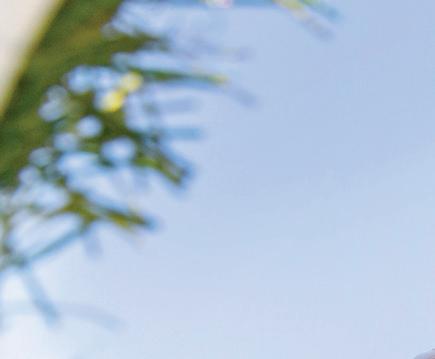
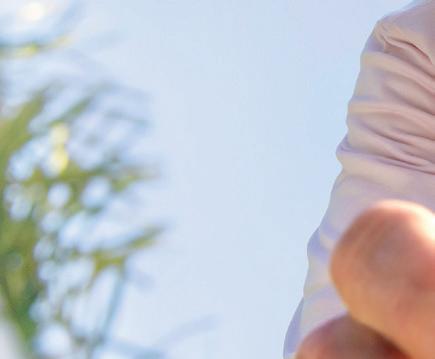

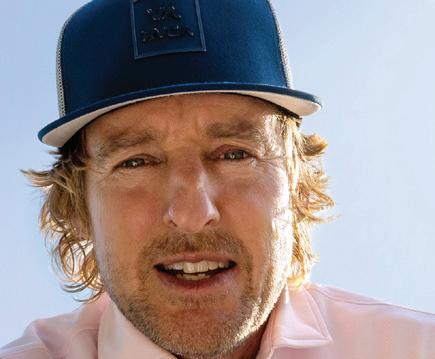


BY ALEX MYERS



OWEN WILSON AND HIS y ounger brother Luke have never had much of a rivalry in terms of acting. The two Hollywood stars have reveled in—and even shared— each other’s successes on screen through the years. On the golf course as of late, however, it’s a different story.
“My brothers and I would be swimming, and we’d see my dad make the turn, and it would be hot in the Texas
summer,” Wilson, now 56, recalls about why he was reluctant to play golf growing up in Dallas. “It was kind of intimidating as a little kid; you’re seeing these guys, and they look kinda serious.”
Eventually, both of Wilson’s brothers—Luke is three years younger and Andrew, also an actor, is three years older—picked up the game, though Owen took longer to get into it. A lot longer. Aside from the odd putting match,
ROLE IT IN
In the new Apple TV+ series “Stick,” Wilson plays a former pro turned mentor. Owen, best known for his hilarious parts in comedy classics like “Wedding Crashers,” “Zoolander” and “Meet the Parents,” seemed destined to never become a golfer until an unforeseen opportunity arose in his 50s.
That’s when Wilson was cast as Pryce Cahill, an over-the-hill former tour pro whose career was cut short, in the Apple TV+ comedy series “Stick.” Wilson’s character sees a chance to have another run at golf glory by taking a 17-yearold prodigy—played by Peter Dager— under his wing. “That’s a theme that people can relate to,” Wilson says of the show that premieres June 4, “trying to recapture something and seeing in this kid a vehicle for his dreams that were kind of derailed.”
To prepare for the role, Wilson got serious about golf. He began taking lessons in May of 2023 at Urban Golf Performance in Los Angeles from Brenton Chan and O’Neill Cowan before seeking help from other teachers as well, including Makena Golf & Beach Club’s Zachary Fahmie. Wilson also pushed past that intimidation he felt as a kid and started playing a lot, mostly to get a better grasp of the game’s vernacular.
“ Most of the time you just use your imagination, but not this,” the Oscar and Golden Globe nominee says of preparing for the role. “I really wanted to prepare because I was nervous. You’re not really going to see my swing. You’re going to see the kid, so it’s really about feeling comfortable on a golf course and also getting to know the dialogue.”
What may have begun as an exercise in method acting quickly grew into a new, real passion, which leads us back to this budding brotherly rivalry. A little over a year after getting into golf, Wilson prodded his little brother, unaware of all his preparation for “Stick,” into taking him out for a round at Bel-Air Country Club, where Owen stunned Luke.
“I could tell he didn’t want to take me to play at his course because he was thinking, This guy’s going to be stum-
bling around and doesn’t know how to play,” says Owen, who enjoyed getting pointers from PGA Tour stars like Collin Morikawa, Wyndham Clark, Max Homa and Keegan Bradley on set. “But I was just dialed in that day, better than I ever had [been] and just played great. He was like, ‘I can’t believe this. This is unbelievable.’ So that was very satisfying.”
In March, Owen, already down to a 14-handicap, made two birdies during a nine-hole rematch at Bel-Air to beat Luke for the first time. “I won some money,” Owen says with a chuckle. “I don’t know why, but he brings out my best game.”
As Wilson has learned, however, the road to golf improvement is filled with setbacks. About a month after that triumph, Wilson was shocked by how
I assure him it’s still a good one. These are the kinds of things Wilson constantly wrote down in a notebook when he was on the course or in a golf simulator preparing for “Stick.” He also read a stack of golf books, including classics like Golf in the Kingdom and Harvey Penick’s Little Red Book. Wilson also watched documentaries on Golf Channel and attended some PGA Tour events to try to soak in even more golf. Not all of Wilson’s golf knowledge was picked up recently, however. He has kept an eye on the majors since he was a kid and gave a vivid recollection of Tom Watson’s close call at the 2009 Open Championship, which Wilson described as the most “crushed” he’s ever been watching a sporting event. He’s long appreciated golf’s drama, even if he only began appreciating playing the game recently.
Wilson stars as an overthe-hill former tour pro who has another chance at golf glory with a 17-year-old prodigy: “That’s a theme that people can relate to.”
much he struggled during a round at New South Wales in Sydney.
“For actors, the example they always give of really preparing for a role is Robert De Niro in ‘Raging Bull,’ when he went to Italy to eat his way around there to put on weight. The only problem is that after all this time, it would’ve been like if De Niro came back, and he was skinner,” Wilson says about his setback.
Wilson has had plenty of playing partners during his two-year golf crash course, including one in Hawaii who dropped a “Did-you-hear-about-theCostco?” joke on him after outdriving him. “They’re putting in a Costco between your drive and mine,” Wilson recalls the partner saying, revealing the punch line before asking if I’d heard that one. Wilson seems disappointed that I have and that it’s usually a Walmart, but
Wilson often tees it up in Maui, where he frequently plays with basketball Hall of Famer Don Nelson, a friend of Wilson’s late father, Robert, who ran the PBS station in Dallas when Wilson was a kid. Wilson has witnessed Nelson make a hole-in-one, and the actor knocked in a 7-iron himself from 165 yards on Makena’s fourth hole. Wilson described that as a “real high,” but he’s quick to say it doesn’t count since it was his third attempt. Nelson has provided Wilson with plenty of golf lines to try out—mostly of the needling variety— but it was something else that the former NBA coach said recently that really stuck with his new golf pal.
“ Nelly said, ‘Your dad would be really happy to see you getting into this game, because he loved it,’ ” Wilson says. “It’s funny because I think about my dad playing. My dad’s gone, but this game that he was always telling me, ‘Oh, you’ve got to learn this game,’ I finally have. That’s a nice feeling to be connected with him in that way.”
Wilson loves feeling connected to the Earth as well, and you can practically hear him uttering his classic “Wowww” as he describes the beauty of playing golf in Hawaii as the sun sets. “It’s the nicest feeling being out there, and you just can’t stop,” Wilson says. “I don’t stop until you have to, until it gets dark.”
BY EDOARDO MOLINARI



TO WIN AN OPEN, YOU MUST embrace the unique test of golf. With unpredictable weather, players who manage their ball-striking and mental game throughout the week are the most successful. For these reasons, it’s often the toughest major to predict a winner, as many long-shot players have won the Open by playing creative shots and keeping a cool head.
There isn’t any shot-by-shot data for Royal Portrush, as the last Open Championship there was in 2019, so to uncover what skills are required to win there, I analysed the stats of recent Open Championships. With the help of Arccos Pro Insights, here are the three skills required to win the Open.
Flighted shots: With current tour venues, playing in heavy winds is less common these days. At Royal Portrush in July, however, we can expect winds to gust over 20 miles per hour at some point throughout the week, requiring players to have command over their trajectory. Being able to hit the ball low and work it both ways is the key. Who does that suit? I looked at the players who have performed best over the past two years on tour in winds of 15 mph or more. Joaquín Niemann, Rasmus Neergaard-Petersen and Shane Lowry top that list.


Accurate drives: In 2019, accuracy off the tee played a massive role. Some of the holes at Royal Portrush are quite narrow, and thick rough lines the fairways. Lowry, who won by six shots, drove it great that week, and an unusual percentage of players at the top of the leader board were straight hitters, like Tommy Fleetwood and Lee Westwood. Six years later, some of the most accurate players off the tee in the field are Collin Morikawa, Aaron Rai and Daniel Berger.
EDOARDO MOLINARI, a former U.S. Amateur champion, Ryder Cupper and three-time winner on the DP World Tour, is Arccos Golf’s Chief Data Strategist.



Adjusting quickly: Tour players are used to putting on greens over 12 on the Stimpmeter. At the Open, due to the high winds and the type of grass, the greens will be much slower, around 10-11 on the Stimpmeter. Players will not only need to hit putts harder than normal on Royal Portrush’s large greens, but slower greens break less than faster ones, so matching the slower speed with the line will take an adjustment. I looked at who over the last five years on tour has putted best on greens slower than 11 on the Stimpmeter, and Sungjae Im, Cameron Smith and Matt Fitzpatrick are near the top, all gaining over 0.7 shots per round on the field on those greens.
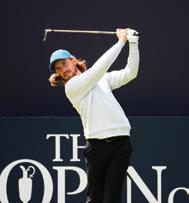

Fleetwood and Lowry excel in these categories, and as Europeans who grew up on links courses, they have years of experience in these conditions. Lowry, of course, won here in 2019, and Fleetwood was runner-up. Fleetwood is long overdue for a major, and this course couldn’t set up better for him, as long as the putter behaves. I also like Niemann and Neergaard-Petersen as they are great players in the wind, and both are having nice seasons so far. Don’t know Neergaard-Petersen too well yet? He’s one of the top players on the DP World Tour; remember what I said about long shots at the Open!





















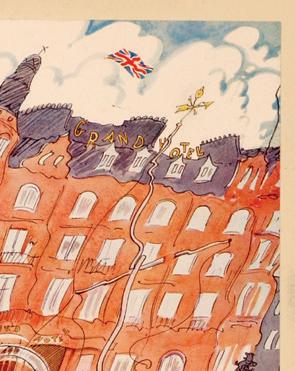
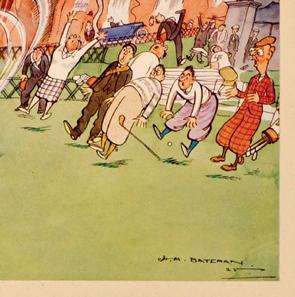
Overcoming serious fi rst-tee jitters as Captain of the Royal and Ancient Golf Club BY
IAN PATTINSON
IN DECEMBER 2023, A SMALL grey envelope dropped through my letterbox—nondescript, save for the crest of the Royal and Ancient Golf Club of St. Andrews, of which I had been a member for some years. Its matching grey letter asked if I would accept the invitation of the Past Captains to become Captain of the Club, starting in September 2024, a singular honour.
The Royal and Ancient, founded in 1754, originally appointed its Captain on playing ability alone. Members historically competed for a Silver Club, the winner of which became Captain for the next year. In 1804, however, the Past Captains decided that they should appoint the Captain but that he must still “win” the Silver Club.
How to ensure the Captain-elect would win the Silver Club? Easy. He is the only person entitled to enter the competition, thus assuring victory. Better still, the Captain-elect need only hit one golf shot to win, irrespective of where the ball goes.
The “competition” for the Silver Club takes place on the last day of the club’s September meeting at exactly 0800 and is colloquially known as “the drive-in.” Typically, 200 or 300 people watch. Members and locals line the area between the Royal and Ancient clubhouse and the first tee of the Old Course. Just as the ball is struck, a ship’s cannon is fired. Yes, that is a C-A-N-N-O-N, positioned near the tee box, and it makes a very loud BANG!
The Captain of the Royal and Ancient Golf Club is the principal ambassador of the club both in St. Andrews and globally. Whatever else the Captain might do during the year ahead, the very first thought is always, What about the drive-in?”
To help manage this process, I codenamed it: Making the Shot. All I had to do, on September 20, 2024, was to drive a golf ball into a fairway 125 yards wide. Surely anyone can do that. One year, in a strong left-to-right wind, a Captain’s ball unfortunately cleared the boundary fence on the right. More than one hooked drive has been saved on the left by the intervention of St. Andrews’ caddies. Caddies? Didn’t I mention them? A dozen or so position themselves in the
fairway to try and gather the ball and return it to the Captain-elect, who then rewards that caddie with a solid gold coin known as a “sovereign,” so called because it carries an image of King Charles III. The sovereign is paid for by the Captain, is linked to the price of gold, and was about 400 pounds. The caddie can, of course, sell it if he wishes (most don’t), although one or two Captains have bought back the sovereign.
A South African Captain once gave a gold Krugerrand, and more recently a Canadian Captain commissioned a special Canadian coin. As for the ball, it is cast in silver and hung on the Silver Club.
BANG! Pattinson hit a beauty in time with cannonfire.
My golf swing involves a steep takeaway and can be erratic. Sometimes, I drop the club inside on the downswing, striking the ball with an open clubface, occasionally producing an ugly block-slice. Often these tee shots cling in-bounds, but to do so on “the day” would be deeply unsatisfying. I was worried that in a strong wind, disaster might result.
In the months beforehand, every time I have driver in hand, I am thinking about “making the shot.” Sometimes I am striping it and feel great but at other times, despair.
Didn’t I read something about visualisation? Who can tell me about that?
I know an Olympic champion who still has the world triple jump record 29 years later and is also a good golfer. I am disconcerted by Jonathan Edwards’ answer—he says he used “negative visualisation” as a spur to success! Another friend, two-time major winner Dottie Pepper, gives me an invaluable tip about pressure, straight from her Solheim Cup playbook, but adds, “Don’t forget to go to the bathroom first.”
Before I “make the shot,” the ball will be teed by the Honorary Professional of the Royal and Ancient, Jim Farmer, a fine player, who has guided 17 Captains through the drive-in. We meet at the range four days before the big day. Before Jim arrives, I have swung my heavy warmup club, hit wedges, 6-irons, 4-hybrids and drivers. Jim notes my preferred tee height. I hit
some drives, angling them across the range toward the far corner of the Old Course Hotel. “I see you’ve still got your speed,” Jim says, adding encouragingly, “Anything like that’ll be just fine.”
The one thing that cannot be replicated on a range is the sound of the cannon, which will coincide with the moment of impact. I see some trash cans with hinged lids on the back of the practice range. Maybe someone

“Whatever else the Captain might do in the year ahead, the very first thought is always, What about the drive-in?”
can slam one shut just as I start my downswing? But I think better of asking fellow range rats to help. Jim and I conclude the rehearsal and will meet at 0715 on the day I must “make the shot.”
I have seen many new Captains drivein wearing a sweater over a shirt and tie, as the Captain must host a formal breakfast shortly after. The legendary Irish amateur Joe Carr was the first not to wear a tie. I have never played golf in a tie, so his example is good enough for me.
I’m staying 150 yards from the first
tee of The Old Course and will meet Jim at the clubhouse before we set off for the range. I have shared the bedroom not only with my spouse but also my driver, as I cannot possibly lose it. I pick up my golf bag as I leave and make for the clubhouse. As I am greeted by Club Secretary Martin Slumbers and Jim, I realise I have forgotten my driver, which remains in the sanctity of the bedroom, so we make a detour and arrive a bit late at the range. I use the same warm up as the other day, but as I get to the 6-iron, I find the lies a bit sandy and start to duff. Then I hit a shank or two. Suddenly, it’s not the warmup I wanted. Jim remains calm, allowing me to complete my process. Before I have even touched the driver, he is saying “You’ve 12 minutes left.” I persist. Just a couple of hybrids before I pull out the big stick. I take aim at the same corner of the Old Course Hotel, and the disastrous shots suddenly don’t seem to matter. A few fly away nicely, gently fading, but that’s OK. “Let’s go,” says Jim, keen for me to finish on a high.
Very shortly, I am back in the clubhouse, refusing the traditionally offered nip of whisky to calm the nerves. I just prefer to follow Dottie Pepper’s advice. Just before 0800 and sensing an out-of-body experience, I hear applause as I leave the clubhouse, following the outgoing Captain, Neil Donaldson, to the tee. He peels off. Jim follows me and immediately tees the ball. I stand and take in the moment.
“Making the shot” has been gestating now for nine months. I have practiced it in my mind a thousand times. I walk into the ball, waggle, inexplicably once more than usual, and find myself swinging back as if in slow motion. On the downswing, I suddenly think, “I wonder when the cannon … ” BOOM! It has fired. The ball is on its way. Unbelievably, it’s the best I have hit all year. I am so relieved.
IAN PATTINSON is the current captain of The Royal and Ancient Golf Club and has served the club and the R&A Group in numerous roles in the last 30 years, including as Chairman of both. This was written in memory of Jim Farmer, who died in November 2024.
A Welsh golf voice shares what it means to see a women’s major arrive on home soil
BY AMY BOULDEN
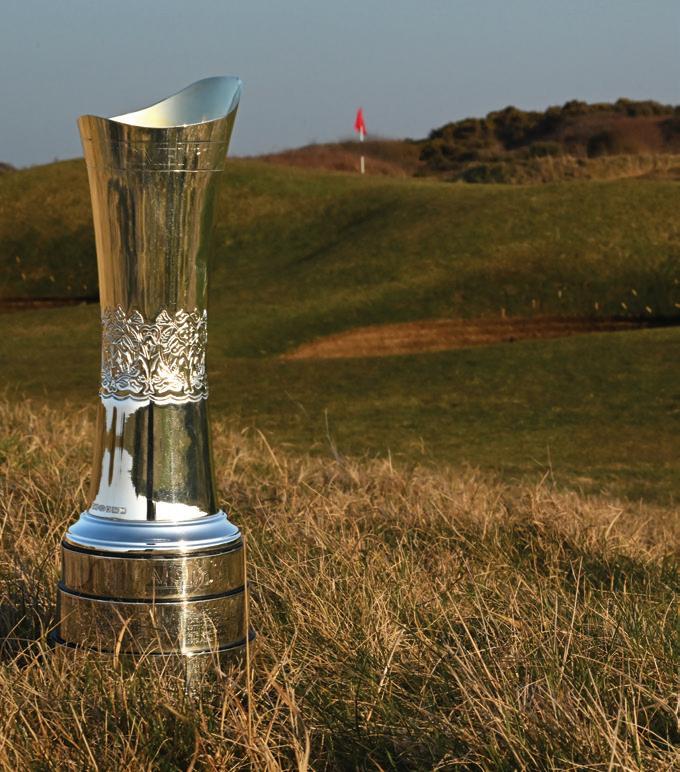
There’s something deeply special about seeing the AIG Women’s Open come to Wales. To have one of the biggest events in women’s golf played at Royal Porthcawl—on home soil—is huge. I sadly won’t be working there this year, as I’ll be commentating at the Legends Tour’s Staysure PGA Seniors Championship, but I’ll be keeping an eye on it for sure!
Porthcawl has always had a place in my heart. It’s one of my favourite courses in the world: a proper links layout, open and exposed, where the wind can change everything. It’s a course that demands creativity, patience, and precision—and it’s about to test the best women players in the world.
I’ve played there plenty of times, and when the conditions turn, it’s no joke. The course’s biggest defence is the weather, without a doubt. When the wind is up, there’s nowhere to hide. And then there are the pot bunkers—
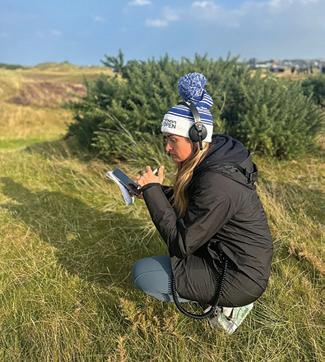
“It isn’t just a big week for the players, it’s a big week for Welsh golf. This is a women’s major.”
AIG WOMEN’S OPEN
ROYAL PORTHCAWL GOLF CLUB
31ST JULY – 3RD AUGUST
plenty of them—waiting to catch anything even slightly offline.
But it isn’t just a big week for the players, it’s a big week for Welsh golf. We’ve hosted great events before, of course, but this is different. This is a women’s major. It’s a moment to put Welsh golf on the map, to show that we have world-class courses, passionate fans, and a deep love for the game.
So I hope this week inspires others, especially young girls. I still remember going to watch this tournament with my parents when I was little. Seeing the best players in the world up close planted the seed that made me want to become a professional golfer. I can only imagine how powerful that same experience will be for the next generation watching in Wales.
IN ACTION
Since retiring, Amy has turned to broadcasting
Even though I’ve now retired from playing professionally, I’m really proud to be involved in various golf broadcasting. While I do miss the competitive side, I’m genuinely enjoying this new chapter. Getting to walk the course, watch the action up close, and bring that to viewers at home is a new kind of challenge—but one I’m embracing. It’s given me a front-row seat to the incredible level of talent especially in the women’s game right now.
Of course, I’d have loved to be there at Porthcawl. You never really lose that buzz during a major week. But instead, I’ll be cheering on the Welsh players who make the field and soaking up what promises to be an unforgettable week for our country, our course, and our sport.
AMY BOULDEN is a former LET professional player, turned on-course commentator.




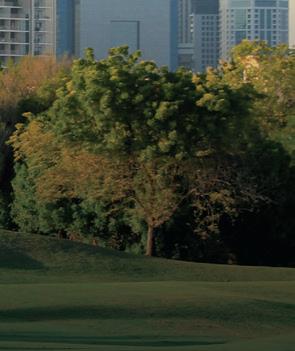























BY JERRY TARDE
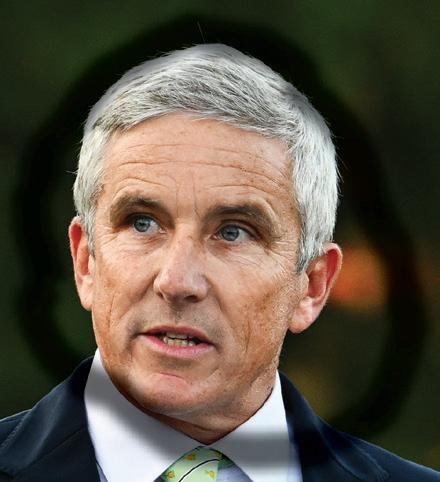






‘Hey, Tiger, I Got an Idea That’ll
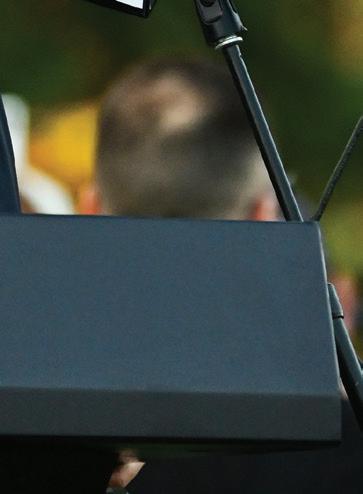
PRO GOLF IS A BIG, UNWIELDY, inefficient business. The rules are set by amateurs based in New Jersey and Scotland. The mega events are operated by three organisations that are not the PGA Tour, plus an independent golf club in Georgia. The tournaments are owned by unconnected nonprofits and local charities, and the workforce is largely volunteer. None of the contestants are under contract to show up. The winner puts the lowest score on the board, not the highest. As Toots Shor used to say, if you swing left, the ball goes right; if you hit down, the
ball goes up; the higher the number on the club, the shorter your distance, and the winner, not the loser, pays for drinks.
Pro golf works because of all these contradictions and complications—not despite them. If you start removing one or more, you risk toppling the delicate scales that hold the game together. Evidence is in the last couple of years of disruption, when the four majors have only gotten stronger, which is a good thing.
Thirty years ago, Frank Hannigan wrote in Golf Digest: “As sports— including golf—become more crass and greed-driven, the anomaly of the Masters grows more appealing and compelling.” A series badge for all four rounds is $450, and it’s arguably the toughest ticket in sports. An egg salad sandwich is $1.50, an imported brew $6. You only get four minutes of commercials in an hour telecast. It’s the most valuable sporting event in the world because it forgoes money in exchange for control, which every other entity has the option to do, but none does. The other advantage of Augusta National is it’s run by one very sensible, benevolent dictator who can do whatever the hell he wants, but does what’s best for golf first.
Nobody at LIV/PIF or SSG or on the PGA Tour policy board has a green coat. I’m not saying you must be an Augusta National member to understand golf—, plenty don’t—but the two who are members, Jimmy Dunne and Ed Herlihy, departed from the tour negotiations because the players think the system is the problem. The system is the solution.
The changing of the guard at golf’s other organisations over the last year—Guy Kinnings at the DP World Tour, Mark Darbon at the R&A, Derek Sprague at the PGA of America, Scott O’Neil at LIV Golf, Liz Moore (interim) at the LPGA—puts all new people in key industry positions.
The PGA Tour has a history of strong commissioners dating back to Joseph C. Dey Jr., who possessed the moral fortitude of Sir Thomas More. I once read in Golf Digest that you could reach into the left breast pocket of his blue blazer and find two slim volumes—the Rules of Golf and the New Testament. “He helped write one of them,” they said.
He was followed by two lions of institutional muscle, Deane Beman and Tim Finchem. Despite their diminutive size, you wouldn’t want to meet either in a dark alley. Beman won the U.S. and British Amateurs with only a dropkick tee ball and a pair of beady eyes. Finchem masterfully maneuvered the tour through recessions and scandals while growing pro golf year after year. I worked with all three, and they were impressive.
Monahan was supposed to be the natural heir, except “better with people.” Then all hell broke loose as LIV Golf entered the picture on his watch,
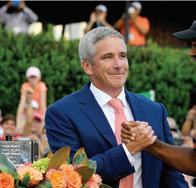


The trouble with the current structure of the tour is that it’s governed by negative vetoes rather than positive momentum.
and there were no right answers. The intrinsic order of corporate life dictates that you throw out the CEO and a new guy starts fresh. Against the odds, Jay hung on and gallantly tried to sort the mess, but the players stripped him of his power in rejiggering the policy board and stacked the vote with their brethren, none of whom, shall we say, attended the Harvard Business School.
The trouble with the current power structure of the tour is that it’s governed by negative vetoes rather than positive momentum. We have the star players in one block (Tiger, Rory,
HEIR APPARENT Is Tiger Woods the best candidate to follow Jay Monahan as commish?
Jordan); then the rank-and-file pros in another (fill in the names of three guys who haven’t shaved in three days); then SSG/Arthur Blank/ Steve Cohen, the money boys who bought into the tour; and Joe Gorder and Joe Ogilvie, representing the policy board. Don’t forget Patrick Cantlay.
Monahan’s contract is up next year, and there are already whispers of who might replace him. (He needs to smile more if he wants people to think he likes his job.) If Jay decides to retire, I have a candidate for commissioner— Tiger Woods. He could return a positive forcefulness and rise to the occasion of acting longterm and not out of selfinterest. Then, a strong CEO would be named under him to run the business.
Tiger’s game is discipline despite a personal life that didn’t always show it. He’s not reluctant to make tough decisions or fire people, and the other players are afraid of him. He has a passion for golf and will to win that’s unmatched. His foundation shows an enduring commitment to give back. He has a fascination with military strategy this could satisfy. He’d be the morning commissioner, and the CEO would handle the P.M. Any business inexperience can be resolved by surrounding him with international talent—unleash the DP World Tour as a true world tour, and you’d be competing with LIV the way Rory kicked Bryson’s butt.
Tiger will be 50 in December. He’s had more than a dozen surgeries, including the recent one on a ruptured Achilles. He’s got nothing left to prove on the competitive field, his play in TGL has been a joke, and legacy-wise there’s little upside for him in joining the Champions Tour. His late mom and pops would have approved. He still loves the spotlight, although his hesitation might be having to face the media more often, but that’s what a CEO is for. He has all the fame and money he’d ever want—this would be for golf.
Commissioner Woods, your destiny awaits you.

EDITED BY RON KASPRISKE

“I’m trying to hole every chip shot. That’s the mind-set golfers should have when they walk up to their ball. It focuses your attention and gets you seeing the slopes and how the grass is growing all the way to the cup. You’ll be thinking about what you want the ball to do rather than the club. When you’re under pressure and thinking about the club, it rarely turns out well.”

A
change
BY DAVE ALLEN
FOR MOST OF HIS CAREER , Nicolai Højgaard has had the upper hand on his younger twin brother, Rasmus, in terms of ball speed and distance off the tee. When Rasmus edged past him in ball speed following this year’s Truist Championship (186.88 miles per hour versus 186.70), big brother likely took note: “Oh, Nicolai won’t like that,” says their swing coach, fellow Danish professional golfer Søren Hansen.
The two brothers are so competitive that “they would bet on which fly on the wall would leave first,” says Hansen, who was a two-time winner on
the European Tour. “That’s why they’ve become so good. They train and do everything together. If you were a boxer and always fought your brother, you’re going to come out stronger.”
The twins might have very similar looks and stats, but their swings couldn’t be more different, Hansen says. They had separate coaches growing up, so Rasmus’ swing is “long and smooth” while Nicolai’s is “short and explosive.”
Although Nicolai’s is very effective at producing power—through early May he averaged 312.5 yards off the tee (13th on the PGA Tour) with a club -
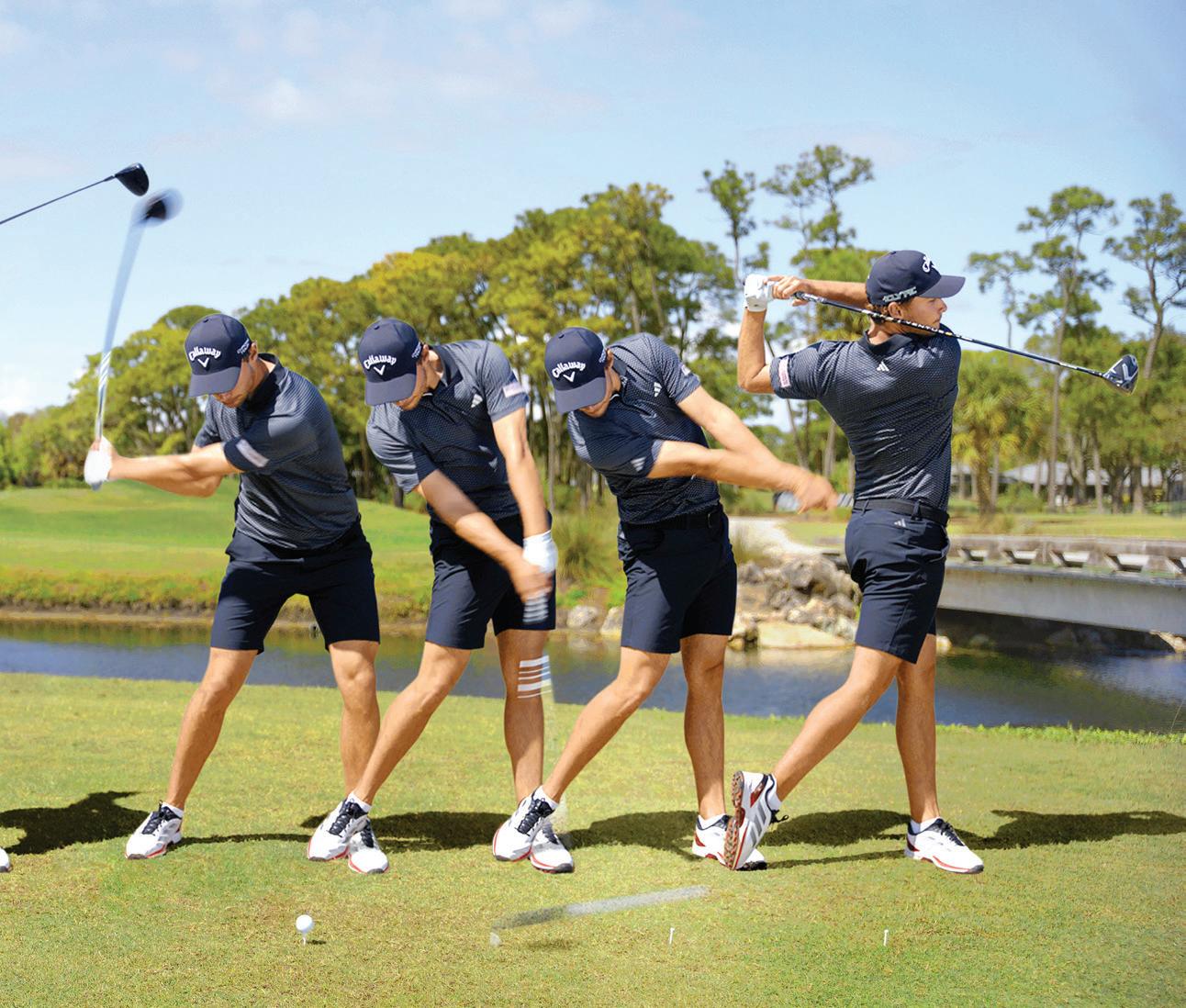
head speed of 123.8 mph (eighth)—his short-and-explosive swing is still a work in progress.
“I’ve always had a tendency to swing very quick and across my chest with no arms, then slide into the ball and drop the club behind me,” Nicolai says. “If I can get my right arm up a little, I feel like I’m stronger. I can keep the club a bit higher and go straight down into the ball. That’s what I’ve been working on. I feel like we’re on to something.”
Nicolai, who was member of Eu -
rope’s victorious 2023 Ryder Cup team and is a winner of three DP World Tour events, says a higher hand position at the top (above, fourth image) helps keep him from getting the club trapped behind his body. When his backswing gets flatter from a lower hand position, that often forces him to spin out or slide and hit a miss to the right.
Hansen, who has worked with the brothers for a couple of years, says Nicolai is staying in the shot longer now because of the backswing adjustment, and that has eliminated the bad tendencies of spinning out or sliding.
“There’s a slight push into the front
part of his left foot at the top of the backswing, and from there he can turn as hard as he wants,” Hansen says. “Nicolai’s arm extension through the ball (above, seventh image) is one of a kind. If you see a golfer in this position, something good has happened before it.”
While there isn’t much length to Nicolai’s backswing, he can generate a massive amount of shoulder turn— a byproduct of his athleticism and tall, lean frame (6-foot-2, 193 pounds). Provided he gets his arm structure correct, he can really turn on the speed.
“If I get my right-arm position right,” Nicolai says, “I can hit the shot I want.”




EDITED BY PETER MORRICE












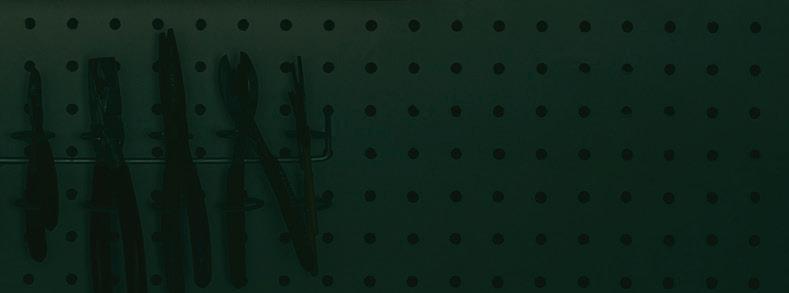

Like the tools on a carpenter’s pegboard, each club in the bag performs a specific job—in the case of utility irons, very specific. These clubs, descendants of the old driving iron, will be in abundance at the Open Championship—75 were in play a year ago. Especially in the wind, they let elite players hit longer shots lower. Are they a better option for you over a hybrid or a 7- or 9-wood? Well, what are you trying to achieve? A utility iron’s flexible face and deeper centre of gravity adds speed and stability, with more shotmaking versatility than a typical wood-like club, but they won’t offer the forgiveness and easier launch of a fairway wood. If you hit those clubs too high, the utility iron is a good choice. It’s all about matching the tool to the task.
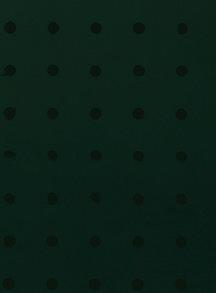


Waiting for the right part of the season is a fool’s errand
BY MIKE STACHURA
We g et it. All of the enticing new clubs on this year’s Hot List have you jonesing for an upgrade. You’re also no doubt aware that the first step is consulting a qualified clubfitter to get you dialed in for that new driver or set of irons. Is now the right time of year to get fit?
If you’re looking for a firm answer that May or July or October is the ideal time for a clubfitting, understand that it’s more of a discussion than a directive. “Number one, golf is an imperfect game, and we as human beings are imperfect, and fitting is an imperfect science,” says Chris Marchini, director of golf experience at Golf Galaxy and lead fitter for the Hot List, “so a ‘perfect’ time of year doesn’t exist.”
The idea that your game needs to be in mid-season form before you go for a fitting is a fool’s errand. Although you wouldn’t want to waltz into the hitting bay when you haven’t touched a club in three months, the timing isn’t going to fundamentally alter the chance for a proper fit. That said, you need to
be in some kind of golf shape before you start the process. Getting somewhere for a few hitting sessions should be enough to get you ready. Feeling rusty shouldn’t stand in your way, says Craig Zimmerman, general manager at RedTail Golf Center in Beaverton, Oregon a perennial selection on Golf Digest’s list of America’s Best Clubfitters.
“One of the major misperceptions is that clubfitting benefits only ‘good’ players,” Zimmerman says. “I still get asked nearly every day, ‘Am I good enough to be fit?’ If a fitter is engaging with the golfer to understand their game, fitting will benefit your game dramatically no matter the time of year, ability level or the form of your swing.”
DIAGNOSIS AND CURE
A fitter will find weak spots first, then look for solutions.
On the flip side, Marchini says, showing up in July after winning the club championship is a bit counterintuitive.
“If you come in telling me, ‘Man, the swing feels great, I’m striping every shot, contact feels great,’ I’m going to look at you and say, ‘Then what the heck are you doing here?’ ”
But timing can be overthought. Marchini says he did an experiment years ago with Mizuno’s Shaft Optimizer, a motion-capture fitting club that diagnoses a golfer’s swing profile to come up with shaft advice. He ran the same group of golfers through the process in late winter and mid-summer, and the recommendations didn’t change.
Still, for golfers in much of the U.S., spring is an appealing time to get fit. First, the array of new equipment offerings is often the broadest. Second, it gives you the time to get the new clubs and work them into your bag before the season gets into full swing.
If you’re coming to a fitting from some downtime, Marchini says getting in some physical reps is worthwhile but so is a little mental prep. Know what your game really needs, understand what misses you’re trying to fix, and be honest about what a fitting might do versus what a commitment to overall game improvement looks like.
As Marchini points out, no matter how good the fitter, it’s not going to be a good fitting if the golfer doesn’t have a plan. Bring your in-round stats or a report from recent simulator sessions to give your fitter some direction about your tendencies. Ideally, you’re not guessing or spending the first 20 minutes trying to find the clubface.
“Nobody’s ever going to come for a fitting and say, ‘I want to make a lateral move,’ ” Marchini says. “But to know what ‘better’ means, you need to do an assessment of your last several months, years, whatever. Fact is, there are 28 million golfers [in the U.S.], and each one’s definition of ‘better’ is different.”
Think about getting new clubs as a commitment, not an impulse buy. If you want to level-up your bag, fitting is the fundamental. Timing is up to you.



Better clubs start with better data — even for beginners WITH HARRY GRIMSHAW
WE SAT DOWN WITH Billy Meyburgh, Master Fitter at eGolf Megastore Al Quoz, to talk about why getting fitted isn’t just for the pros. In this Q&A, Billy explains how eGolf’s AccuFit sessions, top-tier tech, and wide brand selection help golfers of all levels get more from their gear, even Rory!
So Billy, why should an amateur golfer consider getting professionally fitted instead of just buying clubs off the rack? The most basic level of golfers, even beginners, can benefit from club-fitting. Although you might not alter many specifications from a standard set, choosing the right head, shaft and set for your ability, can have huge benefits. At eGolf, we have Professional club fitters that can assist you and it won’t cost you anything. We have never believed in charging expensive fitting fees, it’s simply an industry gimmick to charge the consumer more which we’ve never bought into.
What makes an AccuFit session different from a standard fitting experience? With AccuFit you will get access to PGA & Club Fitting Professionals who will guide you on the best fitting systems. These sessions are booked online, so you won’t have to wait a long time to be assisted. We also offer the widest possible range of brands and products to suit the budget and ability of any golfer, rather than limiting them to 1 or 2 brands which happens a lot. We also focus on a carefully curated range of aftermarket shaft options from the leading shaft companies that we update regularly.
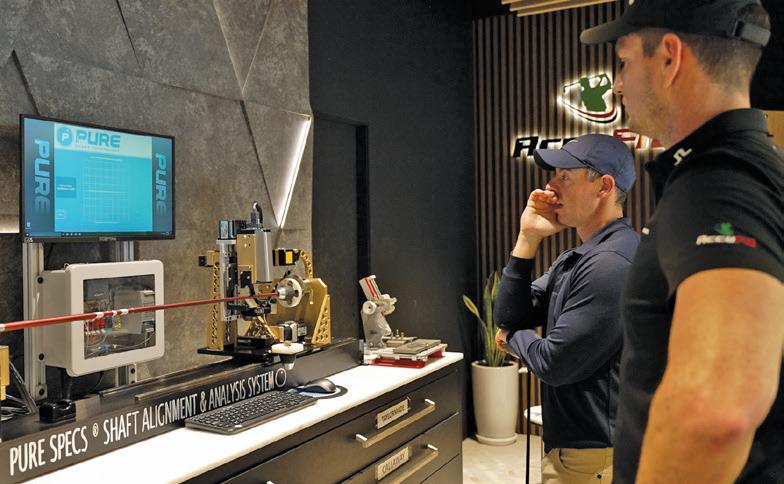
How does eGolf’s wide st selection of brands across the GCC help golfers find the right equipment? When you work with multiple brands you start to realise the differences in performance characteristics. For example, certain brands make irons that spin more, others make drivers that are very good at fighting a slice, some have lighter stock shafts etc. There’s many more examples of this, but the point is that we can identify what is best for a golfers game and recommend a setup based on the strengths of their game. Although clubs can get expensive and we offer premium brands, we also have very good options across different price points, so you don’t necessarily need to spend big money to get a nice upgrade that performs better.
What specific features or technology give players an edge in their gear?
Firstly, we use Trackman4 and GC Quad which are the best fitting systems in the world and used by all the top tour professionals worldwide. Then we have all the latest workshop equipment which allows us to perform services such as regripping, club component assembly, frequency matching, loft/lie changes and basically anything else you can think of. In our new Al Quoz build shop, we also have the only SST Shaft PUREing machine in the Middle East, which helps golfers get extra performance out of their shafts.
How important is it for amateur golfers to have access to the same level of fitting that pros rely on — and how does eGolf deliver that? I believe that it’s important to get assed for golf equipment regardless of your skill level. As a high handicap you might not see any difference by splitting hairs with bending clubs by half a degree, or altering length by 5mm. But at the very least the fitting process can help you identify head and shaft combinations that’s best for the way you generally deliver the club. Even if you are not consistent, getting some launch monitor data can remove any guesswork and you can then be rest assured you will get a good result if you make a decent swing.
Rory McIlroy visited eGolf Megastore in Al Quoz and praised the setup. What does that say about the quality of the fitting experience on offer? Obviously, Rory has access to the best facilities in the world through TaylorMade, and for him to be quite impressed with our setup was a very big compliment to us. Our goal was to create a world class facility dedicated to all aspects of club fitting and building, and this is a testament that we have achieved. We strive to offer the latest technology and best possible experience to our customers. We have more than everything we need to offer and for Rory to compliment us on that was a proud moment for the team.













We don’t like answering questions with “It depends,” but choosing shaft specs comes down to the player you are and what you’re trying to accomplish.
The flex, weight and length of the shaft all influence how a golfer times the release of the clubhead at impact, which is critical for consistent contact. Complicating things a bit is the fact that there’s no universal flex spectrum across the industry. Another wrinkle is a shaft’s “EI profile,” which is a measurement of the stiffness along the entire shaft—not to get too far in the weeds.
More than with any other piece of gear, it’s imperative that you seek out a qualified clubfitter to discuss shaft options or, at the very least, use a launch monitor to establish launch, spin and carry baselines for all of your clubs. It’s hard to know without some good data if you’re playing the right flex.
Q: IS THERE AN OPTIMAL TEE HEIGHT WITH THE DRIVER?
How high you tee the ball affects carry distance, as does your angle of attack into impact. If you optimise attack angle and launch, your drives get longer.
In most cases, swinging up on the ball with the driver is the recipe for more distance. But if you don’t want to monkey with your swing shape, one easy way to add yards is to change the tee height.
To test this idea, we used the Golf Laboratories swing robot to simulate a typical attack angle (2 degrees down) and swing speed (95 miles per hour).
The robot hit balls with a 10.5-degree driver out of the geometric centre of the face to produce a carry distance baseline. Then we set the tee higher or lower and had the robot hit below and above centre at .3 inches and .6 inches.
BEND GAME LPGA player
Charley Hull knows how to flex it.
How you deliver the club at impact— known in launchmonitor lingo as angle of attack—will determine if you’re better off with a shaft that has a reinforced tip to keep launch and spin down or if you need a more lively one for higher launch.
In some cases, you could benefit from having both in the bag. For example, a descending impact with the driver will impart excessive spin on the ball, which might require you to play a shaft that’s stiff from end to end. On the flip side, the same descending blow with an iron helps optimise launch and spin, so it’s possible you might not need a robust shaft through the rest of your set.
A fitter can help you determine if it’s better to maintain the same launch and spin profile from club to club or make some adjustments along the way. A beefy shaft in the irons might not work for touch shots inside 75 yards, so don’t be surprised if you wind up with something softer in your scoring clubs.


Let’s look at the results: Centre strike: 241 yards
.3 inches below centre: 232 yards
.6 inches below centre: 219 yards

.3 inches above centre: 244 yards
.6 inches above centre: 237 yards
If you tend to hit low on the face—a common mis-hit your launch is likely too low and spin is too high That’s why a strike .6 inches below centre went 219 yards compared to 241 on centre.
In short, you might add 20 yards—still hitting down on the ball—just by raising your impact point with a higher tee.
Answers by Golf Digest’s equipment editors Mike Stachura, E. Michael Johnson and Jonathan Wall


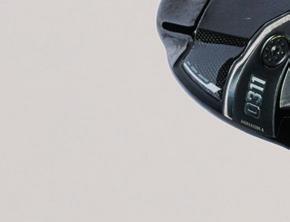

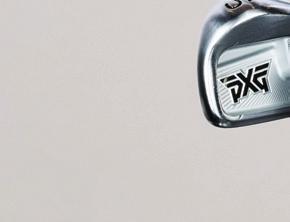




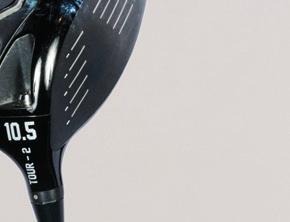




AGE 30 LIVES Johannesburg, South Africa STORY Won three times on the






DP World Tour. Finished runner-up last year at The American Express on the PGA Tour. COMPANY MAN
PXG is a brand-new





Carry distance


partnership for me, and I’m super impressed by the whole ethos of the company. Nothing is too much trouble for them. They’ve delivered from the get-go, giving me all the apparel and clubs I need. I couldn’t ask for more.
—WITH JONATHAN WALL


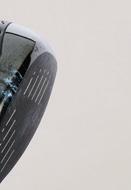


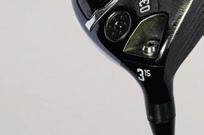


SPECS PXG Black Ops Tour-2, 9.8°, UST Linq White 7TX shaft
I prefer more loft, so I can see the face. This is a 10.5-degree head, but I use the adjustable hosel to bring it down to 9.8. I saw a ball-speed jump of 2 to 3 miles an hour over my previous driver. It’s more forgiving, too. I changed the shaft at The American Express to get more feel in the handle. I like to feel where the club is during the swing.

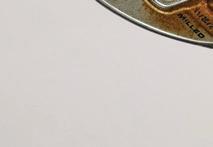


SPECS 50° and 56°: PXG Sugar Daddy III, True Temper Dynamic Gold X100 shafts; 60°: PXG Sugar Daddy III, True Temper Dynamic Gold S400 shaft
These are one-o wedges made specifically with my personal grind. I’ve always been a good wedge player, so when I went to PXG, that was one of the main things we needed to get right. I change my 60 every couple of weeks. This one is only a week-and-ahalf old, and it’s already getting worn.
SPECS PXG Black Ops, 15°, Mitsubishi Kai’li Blue 70TX shaft; PXG Black Ops, 18°, Fujikura Ventus Black 9X shaft
I usually don’t like changing equipment, especially my fairway woods, but these were a pretty easy switch. I really like how they sit on the ground, and I’m hitting the same numbers as my old fairway woods. Plus, I like the look of these much better.

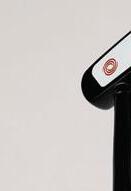
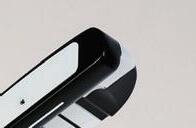

SPECS Odyssey Works Big T #5, 3°, 35 inches, Two Thumb Snug Daddy 30 grip
I’ve had this style of putter in the bag for seven years now, and this specific one for two-plus years. It just suits my eye. You can see the wear mark on the face, and those centre hits don’t come easy. I recently added the line on the top to help with alignment. I have a tendency to line up on the toe. This gets me matched up with the middle of the putterface at address.




SPECS 4-PW: PXG 0317 CB, KBS Tour 125 S+ shafts, Golf Pride Tour Velvet 58R grips
I have a 20-yard gap between my 5-wood and 4-iron, so I bent the iron a little stronger. Everyone thinks tour players play nothing but muscle-back blades, but I’ve never played a blade in my life. The game is hard enough. These launch a little higher. I want to make it as easy as possible.
FEELING IT
I’ve tried the Pro V1x, but the Pro V1 feels better around the greens. The dots are something I’ve always done to identify my ball.
FOR COUNTRY
I represented South Africa in the last two Olympics. This divot tool is a nice little reminder of those incredible weeks.
LUCKY CHARM When I was a junior, I found this poker chip, threw it in my bag as a ball marker and played well. I’ve used it ever since.







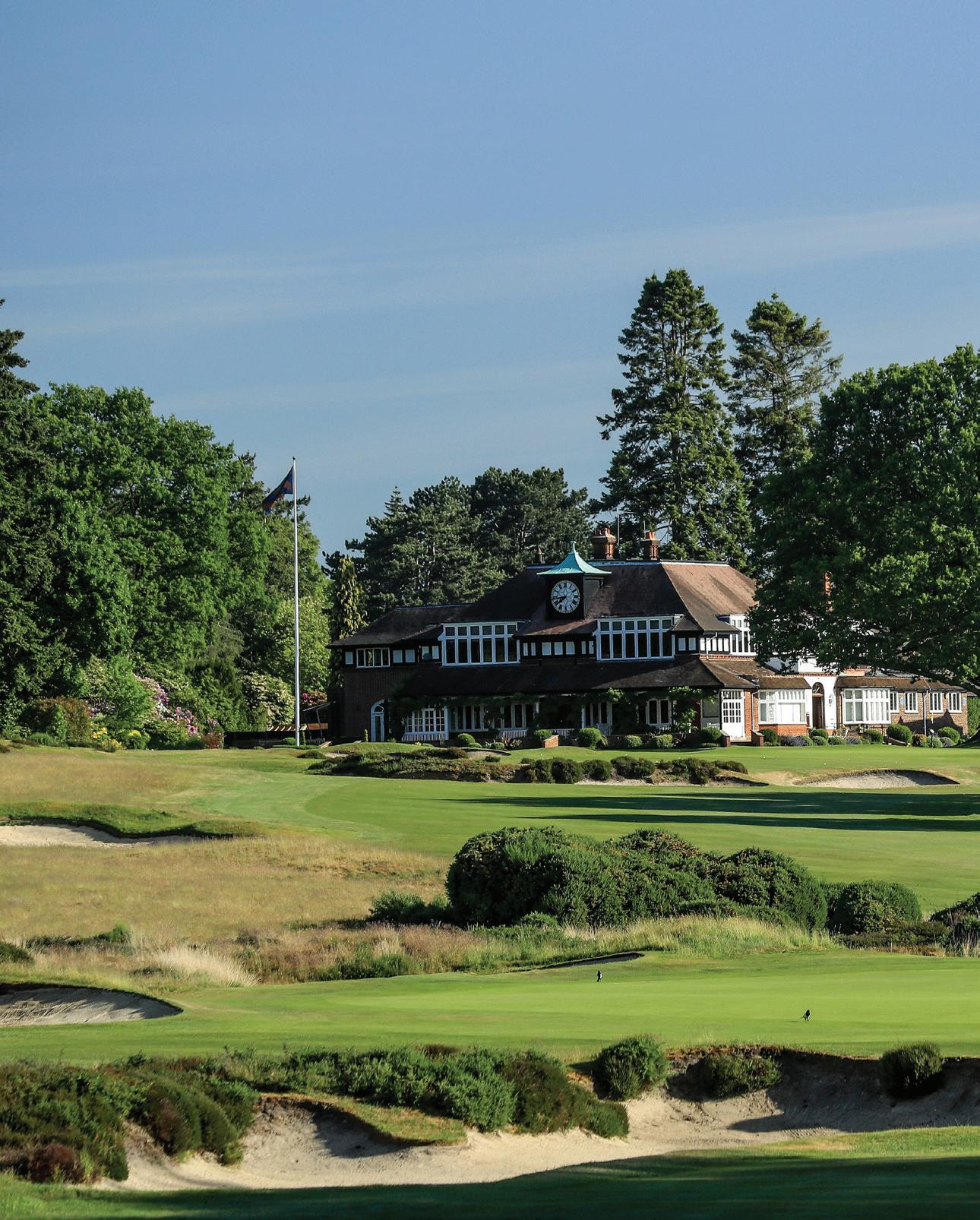
EDITED BY HARRY GRIMSHAW

The ISPS HANDA Senior Open returns to Sunningdale’s Old Course — one of the world’s most revered inland layouts. Major winners, Ryder Cup stars, and legends like defending champion K.J. Choi, four-time winner Bernhard Langer and ISPS HANDA Ambassadors Thomas Bjørn, Ernie Els, Pádraig Harrington and Colin Montgomerie will compete for Europe’s only Senior Major title. Set in the Berkshire countryside, Sunningdale blends tradition, charm, and elite golf. With a storied past and iconic design, the Old Course promises another unforgettable chapter in Senior Open history.


BY HARRY GRIMSHAW
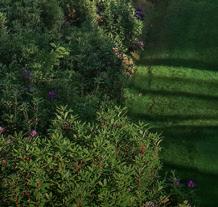
Major champions, Ryder Cup legends and icons of the game return to Berkshire for the 2025 ISPS HANDA Senior Open.

THE LEGENDS OF THE GAME return to the UK’s golfing heartland this July, as the ISPS HANDA Senior Open touches down at one of the world’s most well-regarded inland layouts — the Old Course at Sunningdale Golf Club.
From 24–27 July, a world-class field of Major winners and Ryder Cup stars will gather to contest Europe’s only Senior Major Championship.
Following a dramatic 2024 edition at Carnoustie, where K.J. Choi made history as the first South Korean to capture a Senior Major title, the focus now shifts south of the border to Berkshire. Choi will return to defend his crown on a course


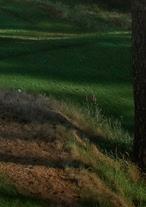
steeped in tradition and having already committed to a rare double — playing both The Open at Royal Portrush the week prior, and then defending his title at Sunningdale.
Joining the 2024 champion in the field are a host of ISPS HANDA Ambassadors Thomas Bjørn, Ernie Els, Pádraig Harrington and Colin Montgomerie. They will be joined by four-time winner of The Senior Open, Bernhard Langer, the most decorated senior player in history, who recently brought his Masters career to a close at Augusta National. Langer will make his 17th consecutive appearance in this championship, having never finished worse than T12. He was in fact runner-
OLD COURSE
Designed by Willie Park Junior and opened in 1901, Sunningdale’s Old Course is a classic heathland golf course.
Par 4 — 488 yards
One of the toughest holes on the course, this long twoshotter plays uphill with a slight left-to-right shape. Deep fairway bunkers and a green that slopes from back to front make this a true test of distance control. The view of the hole from the Half Way Hut, behind the tee box, is something to treasure.


up the last time this event was played at Sunningdale.
First played in 1987, The ISPS HANDA Senior Open has been held on some of the United Kingdom’s most celebrated and historic courses. Sunningdale first hosted the Championship in 2009, when American Loren Roberts defeated compatriot Fred Funk and Irishman Mark McNulty in a play-off.
Designed by Willie Park Junior and opened in 1901, Sunningdale’s Old Course is a classic heathland golf course. With pine tree-lined fairways, tracks of purple heather, and elevation changes, it is widely regarded as one of the finest inland courses on the planet.
Originally built on land owned by St. John’s College, Cambridge, Park’s design was a revelation at the time, showcasing how inland layouts could rival links courses in challenge and character. His architectural style is visible throughout the Old’s routing, bunkering, and signature undulating greens — features that reward both creativity and precision.
Later refined by Harry Colt, who relocated several greens including the nowiconic 4th, 7th and 12th, the course has stood the test of time without reliance on length. Instead, it demands strategic placement, shot shaping, and a deft touch on and around the greens.
Par 4 — 423 yards
A magnificent finishing hole framed by pines and heather. Accuracy off the tee is vital to avoid the fairway bunkers, leaving a mid-iron into a contoured green sitting below the historic clubhouse. It’s a hole worthy of crowning a champion with the Clubhouse and iconic Oak Tree at the back of the green.
Located just 45 minutes from central London and set amidst the rolling Berkshire countryside, Sunningdale offers a quintessentially English golf experience — charming, understated luxury paired with tradition-rich hospitality. With its ivy-clad clubhouse, panoramic terrace views, and admiration for the game, the club embodies everything great about British golf heritage.
The 2025 edition of the ISPS HANDA Senior Open promises to deliver another unforgettable chapter in Senior Major Championship history.
For more info, visit legendstour.com

The Dubai Creek International Pairs Tournament
DU BAI CREEK GOLF & YACHT CLUB has officially announced the Dubai Creek International Pairs Tournament, taking place from 8 to 13 December 2025, offering the ultimate
golf aficionados a unique blend of worldclass competition combined with luxury hospitality on Championship courses.
The six-day event will unfold across two of Dubai’s most iconic courses: the Championship course at Dubai Creek
and the Earth Course at Jumeirah Golf Estates, home of the DP World Tour Championship. The tournament will feature three rounds of Better Ball, open to any pairing of amateur and professional golfers.

“We created this event to showcase everything the resort has to offer – from championship-level golf to five-star hospitality,” said Michael Major, Director of Golf at Dubai Creek. “It’s more than a competition – it’s a curated experience where guests enjoy the game at its finest while relaxing and connecting in a luxury setting.”

The six-day event is open to all amateur and professional golfers.



Throughout the week, participants will stay at the awardwinning Park Hyatt Dubai, with access to world-class facilities including the chic Lagoon Beach by Twiggy, 14 on-site restaurants, and a carefully designed itinerary that balances sport and leisure. During their downtime, participants can make the most of everything the resort has to offer, whether it’s sharpening their skills at the Dubai Creek Academies— which includes tennis and padel facilities—or unwinding at the award-winning Amara Spa. For a touch of luxury, there’s also the Rossano Ferretti Hair Spa, led by celebrity stylist.
Highlights of the week also include a welcome event, complimentary practice round, airport and golf course transfers, and premium branded amenities.
“The pairing of Dubai Creek and Jumeirah Golf Estates brings together two very different but equally compelling golfing experiences,” Major added. “It reflects not only the quality of Dubai’s golf offering but also the seamless service and connectivity we provide for our guests.”
The 2025 tournament is positioned as a one-of-a-kind experience for international golf travellers, mixing the spirit of friendship with competitive play, all set against the backdrop of Dubai’s luxury lifestyle offering. Packages start at AED 14,000 per person, with single and double room options also available.
Monday, 8th December
• Check-in at Park Hyatt Dubai.
• Practice round at 1:00 PM with a shotgun start at Dubai Creek Golf & Yacht Club.
• Welcome Event at 7:00 PM.
Tuesday, 9th December
• First round of the competition with a 9:30 AM first tee-off at Dubai Creek Golf & Yacht Club.
Wednesday, 10th December
• Second round of the competition with a 1:00 PM shotgun start at Earth Course, Jumeirah Golf Estates.
• Transfers depart from Park Hyatt Dubai at 10:30 AM, with a return at 5:30 PM.
Thursday, 11th December
• Rest day with free time to enjoy Dubai and hotel facilities.
Friday, 12th December
• Final round of the competition with a 7:30 AM shotgun start at Dubai Creek Golf & Yacht Club.
• Prize Giving Ceremony & Gala Dinner at 5:00 PM at the Palm Garden at Park Hyatt Dubai.
Saturday, 13th December
• Check-out from Park Hyatt Dubai.
• 5-night stay at Park Hyatt Dubai
• Daily breakfast at Park Hyatt Dubai
• Tournament entry with three competitive rounds at Dubai Creek Golf & Yacht Club and Earth Course, Jumeirah Golf Estates
• Practice round at Dubai Creek Golf & Yacht Club
• Welcome Event
• Final Prize Giving & Gala Dinner at the Palm Garden at Park Hyatt Dubai
• Airport transfers (Dubai Airport – Hotel –Dubai Airport)
• All golf-related transfers between Park Hyatt Dubai and Jumeirah Golf Estates
• Tournament golf shirt
• Driving range balls for practice
AED 17,000 per person | Single Room Package
AED 14,000 per person | Double Room Package
TO BOOK OR FOR MORE INFORMATION, PLEASE CONTACT: golfbooking@dubaigolf.com +971 (0) 4 380 1234 dubaicreekresort.com/golf






Attractions
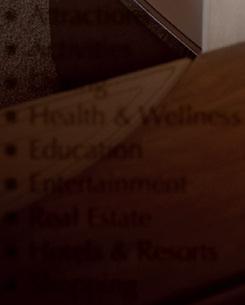


Activities
Dining
Health
Education
Entertainment
Real Estate
Hotels & Resorts
Shopping
The

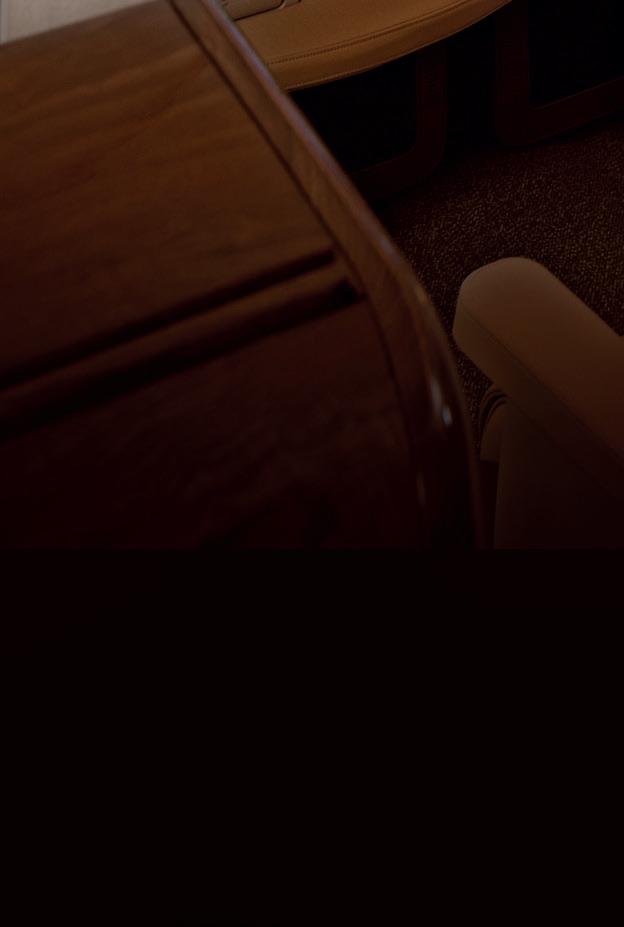


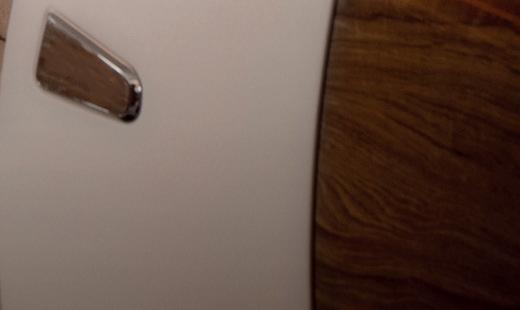










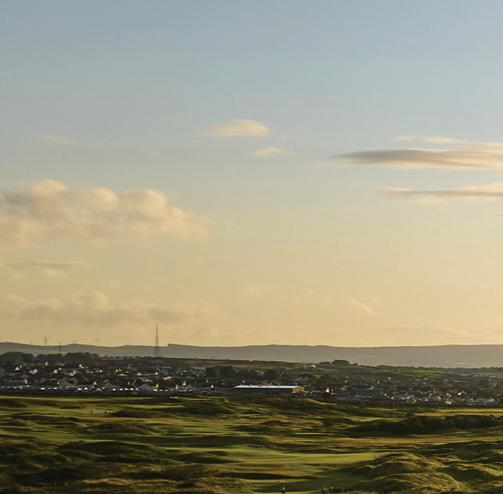




Why the Northern Irish links is unique in the Open rota
BY DEREK DUNCAN


VIEWERS ACCUSTOMED to watching the Open Championship contested at the same venerable eight or nine courses each summer, not to mention the players competing on them, became smitten with Royal Portrush in Northern Ireland when the competition traveled there in 2019. It was the first time the major had been held outside of England or Scotland since 1951, when it also visited Portrush.
We’re still getting to know Royal Portrush, but we like what we see. That first flush of feeling will be rekindled when


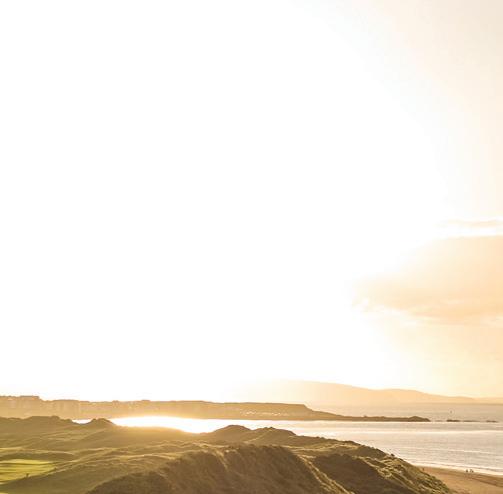


the club’s Dunluce Links course hosts the Open again July 17-20. With all due respect to those who might have been on hand 74 years ago for the initial foray into Northern Ireland, won by Max Faulkner, the 2019 event was the real coming-out party for Portrush, wowing players and spectators with its beauty, formidability and fresh energy.
Royal Portrush’s perennially saturated shades of emerald and ochre stand in contrast to the more washedout, off-greens and tans recognisable at venues like Hoylake and Lytham & St. Anne’s. The setting along sheer


ON THE EDGE: Portrush’s fifth green teeters on the cliffs of the North Atlantic.
bluffs overlooking the North Atlantic matches Turnberry for visual drama. The holes memorably wind through some of the choppiest dunes among Open Championship courses, many strung through valleys like Royal Birkdale and others cresting over ridges like Royal St. Georges, working in tandem with elevation changes that have no peer. Portrush’s fairway bunkers, residing mainly within rather than on the edges of fairways, control lines and
strategy as effectively as Muirfield’s.
The greens of links courses, particularly older courses, are generally not known for electric contour. Many sit low to the ground as extensions of wavy fairway and surrounding grades, ready to settle low shots that come bounding in under the ocean gales. Once more, Portrush is different. Its greens, originally designed by Harry S. Colt during his complete remodel of the course over new land in 1932, possess swales, pockets and crests that are common to Irish links but extreme to Scottish or English designs outside St. Andrews. Colt’s






Royal Portrush was love at first sight. The chemistry seems right for a long relationship.
magnificent surfaces, particularly at the par 3s and holes like the par-4 first and par-4 14th, remain original. When remodeling was necessary at several existing greens, as well as at two new holes created in 2016 (the seventh and eighth), British architects Martin Ebert and Tom Mackenzie attempted to


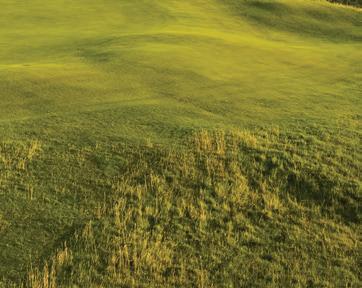
replicate Colt-like shaping. These internal movements create unique hole locations that can be challenging to get close to and complicate the paths of long lag putts, testing pace and break.
More important to the unique character of Portrush might be the areas around the greens and their wild formations. Many of the putting surfaces are nestled snuggly into dunes or surrounding mounds—the par-4 fourth and par4 11th are examples. More commonly, the surrounds sit above the fairways with edges that spill off into low basins and ravines leaving delicate pitches and chips from awkward stances. Avoiding these depressions—especially the deadliest hollows like left of No. 1, long left


on the par-3 sixth, the ferociously deep bunker left of the par-4 14th and all along the right side of the 236-yard par3 16th, one of Portrush’s most famous holes known as Calamity Corner—is the key to keeping good rounds alive.
After winning by six strokes in 2019, Irishman Shane Lowry, who described Royal Portrush as “incredible,” was more prescient than witty. “Everybody has been raving about how good the golf course was,” he said. “I’d be very surprised if [the Open] is not back here in the next 10 years.” It took only six because the sentiment behind the decision is the same: Royal Portrush was love at first sight. The chemistry seems right for a long relationship.
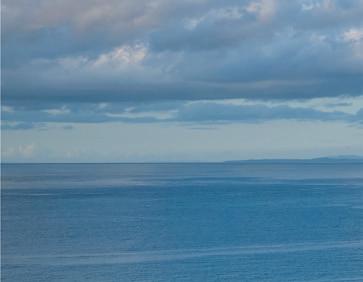
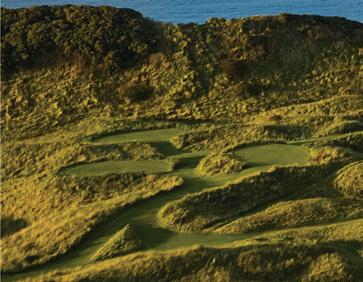















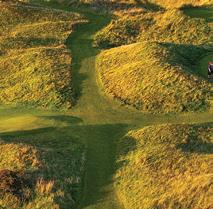


TROUBLE LURKS: Crowned putting surfaces like the par-3 third make for tricky recoveries (opposite page). Wind, turf and contour are the only defense needed at holes like the par-3 sixth (above). The approach to the 15th green is one of the most exacting— and inspiring (left). The tee shot on the par -3 16th hole at Calamity Corner, very often plays straight into the wind (below).
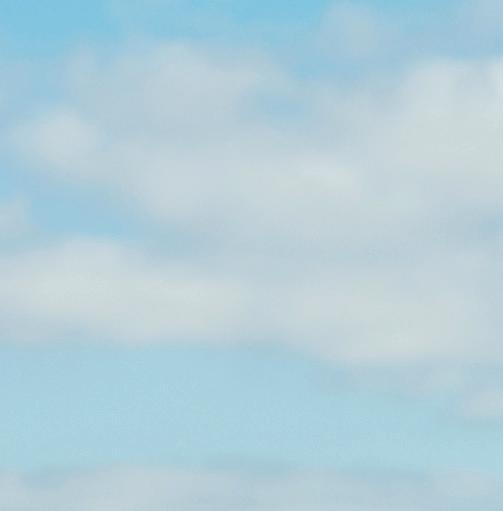











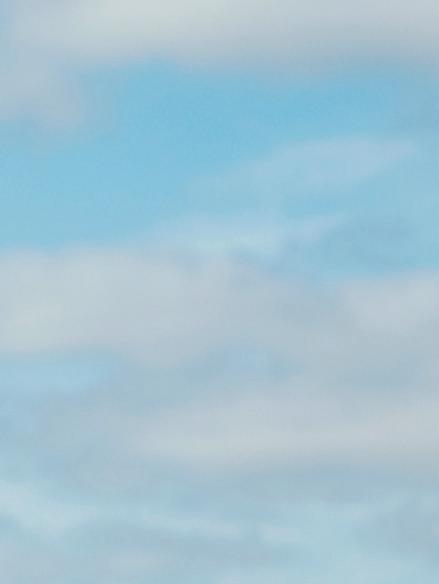
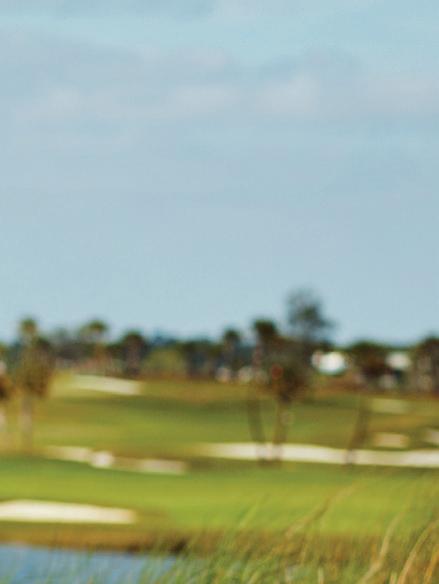

WHAT I DID TO BREAK THROUGH AND WIN MY FIRST TWO MAJORS AND HOW YOU CAN GO ON YOUR OWN RUN BY XANDER
SCHAUFFELE
WITH PETER MORRICE
PHOTOGRAPHS BY ADAM RIDING
Last year at Royal Troon, after the speeches were done and the crowds were gone, my dad and I finally had a moment to reflect and enjoy it all. I remember, he was scanning the names on the claret jug, then looked up at me and said, “You still suck.”
We had a good laugh over that one. Maybe you have to understand my dad to get his little jokes, but those words actually packed a lot of meaning. He was reminding me that, despite the success of the day, there’s always more to do, more you can achieve, a higher bar. That’s how we look at it.
Winning the PGA last May and then following it with the Open Championship was amazing to me but not unbelievable. I’m a process person. Results





come when you follow the right steps. I’m lucky to have a great team that helps me constantly evaluate my body, mind and swing, leaning into what’s working and taking out what’s not.
I’ve made a few swing changes to hit the shots I want to hit more often, and I’ve gotten stronger, which has given me more speed. On a broader level, I’ve worked with my performance coach, Dr. Ara Suppiah, to better control how I feel day to day—he calls it my “availability”—so I can get more out of all the other things I’m doing.
Let’s take a look at what I’ve focused on to push my game to the next level. I think you’ll see some ideas here that’ll work for you, too.

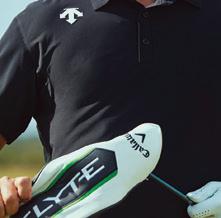
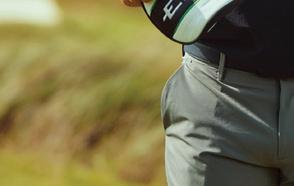
I’ve always been a pretty clean eater, but I wasn’t putting the right fuel in my body. I’d avoid carbs and go stretches eating less to try to feel fit. Ara had me add low-sugar carbs, like brown rice and sweet potatoes, and healthy fats—nuts, avocado, eggs. I actually increased my
calorie intake. If your body isn’t primed for action, it’ll break down under stress.
When it comes to fitness, mobility was our first stop. One issue for me was something a lot of people struggle with—thoracic-spine mobility, which dictates body turn. So we started with that and added strength work with my trainer, David Sundberg,






also addressing my upper back and shoulders to fight the “caved-in” posture that golfers tend to get.
Cardio was another target because a better cardio base helps me train harder, hit balls longer, compete six weeks in a row, and so on. Golf is sneaky demanding on your body. I prefer the bike for cardio because my
running form isn’t great, plus it’s way easier on your joints.
The last piece was rest and recovery. I was doing some goofy stuff, like cold showers and working out at night. Ara got me thinking about winding down, sleeping in a cool, totally dark room. Also, I’m better about chilling out without feeling lazy, letting my energy bounce back.
My dad used to make yardage books for me when I was a junior golfer, and that phrase above found its way into all of them. It’s in my DNA now, and it still jumps into my head sometimes during rounds. I take pride in being disciplined: quickly picking my shot and club, having a simple key to execute, then taking whatever happens. Good shot or bad shot, move on.
I also remember my dad asking me when I was about 15 if I was a Tiger or a Freddie. Tiger wants to know all the mechanics of the swing, what causes what, and Freddie doesn’t like the details. I’m definitely wired more like Tiger, so he started explaining everything we were doing, step by step. Obviously, either way works. I think you just have to be consistent and true to yourself.
At this point in my career, I’d tweak
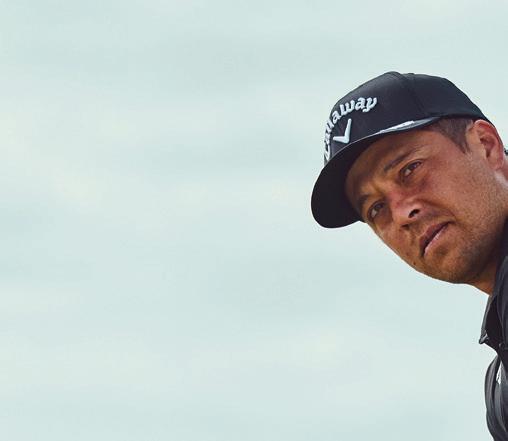

the phrase a little and lead with “accept” because I’ve learned that respecting the outcome before you do anything is so powerful. There’s a lot I can’t control, like the rib injury that kept me out of the first two months of this season. I spent a lot of time lying around, streaming TV shows and watching the guys play. I had to be OK with that. I did some feeling sorry for myself, sure, but that old phrase would snap me back.

2024 SCORING AVERAGE (RANKED 2ND ON PGA TOUR)






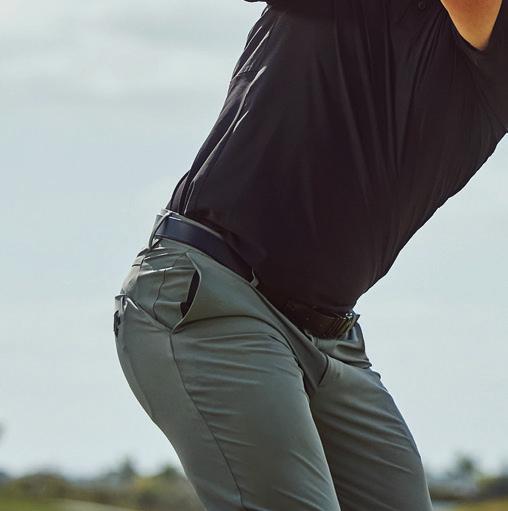


During Covid, I played a lot of golf at a little course in San Diego called The Farms. The fairways there are supertight, so I started hitting low cuts for control. Problem was, I got into a groove of swinging out to in, with the club laid-off at the top (pointing left of the target). That made it hard for me to hit the draws I like when I got back on tour. I needed to break out of that.
In 2023, I asked instructor Chris Como to help me with my swing. To start, Chris had me track down all the old swing videos I could find. He noticed that my club at the top was a lot more on plane a few years ago. We started retooling my backswing into more of an in-up-and-around shape, which to me felt like I was crossing the line at the top (the shaft pointing right of the target). We also worked to get my shoulders turning on a steeper angle going back. This put me in a more neutral position at the top, so I could hit fades or draws, which I always want to be able to do.

Two lessons here for you: First, video your swing a lot, especially when you’re hitting the ball the way you want, so you have a baseline to check against. Second, if you have a dramatically out-to-in or in-to-out swing path, try to work back toward the centre. The dispersion of your misses will be tighter, and you’ll be able to hit a bigger variety of shots.




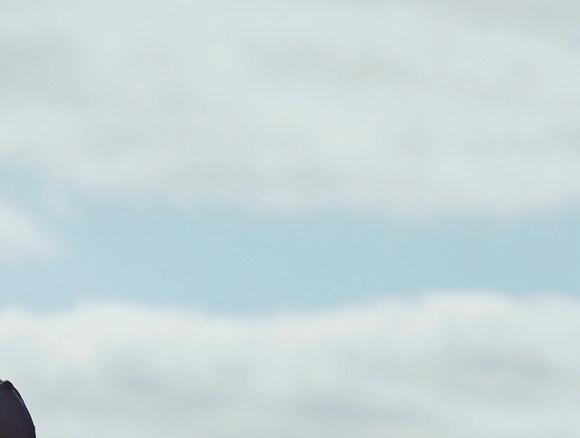


I got my start in golf going to a local range, first trying to hit the 100-yard sign, then the 150, and so on. Like most kids, I loved experimenting, trying to pull off shots and, of course, swinging as hard as I could. Those early years taught me to love shotmaking.
When I go to the range now, I still spend a lot of time working the ball different ways. I’ll hit five slices, then five hooks, calibrating how to deliver the face to create those flights. Trying to hit shot after shot the same way gets boring and also doesn’t prepare you for the course, where the situation is always changing. Playing golf is about adapting, not hitting stock shots.

That said, getting back to basics is an important part of practice. I have one of those formed grips on a 7-iron, so I can check my hand positions—my left hand tends to get turned too strong. I also use a T-square to monitor my alignment and distance from the ball. Little things that are easy to fix can put you back on track fast.
When I practice on the course, I try to take on uncomfortable shots. If there’s a water hazard on the left or right, I’ll aim in the middle of the water and try to turn it back to the fairway. Raising the degree of difficulty is good training. I’ll even do it in competition because it’s great prep for the majors. I want to be ready for those more than anything.
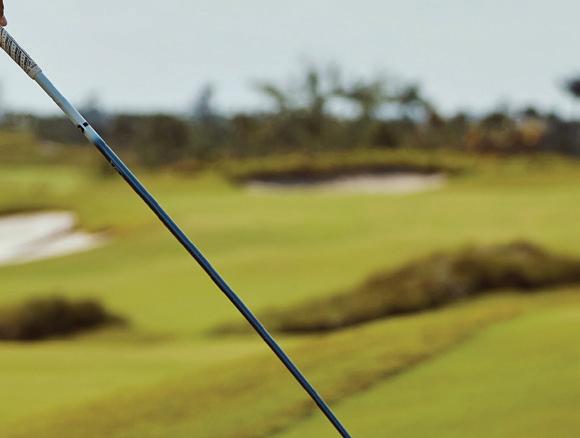


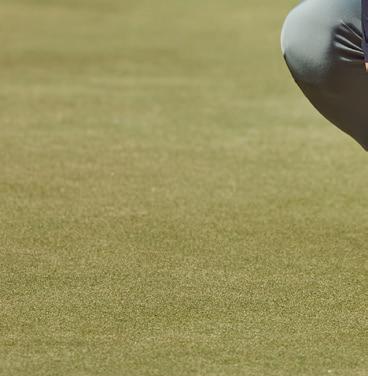


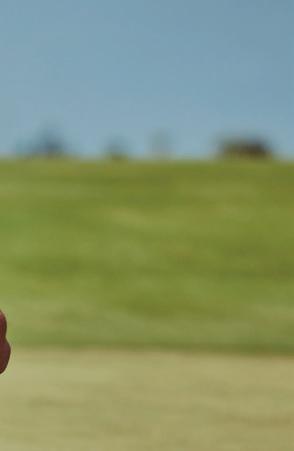


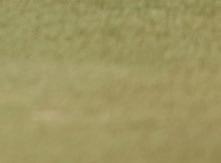
The good news about putting is, you’re probably already dedicating time to it. When you roll some putts before you tee off, that’s legitimate practice time—if you use it well. The key is to make the reps good reps, not just rapid-firing putts from hole to hole.
I’m very intentional when practicing putting thanks
to my putting coach, Derek Uyeda. First, I read each putt like I would on the course. If the putt has some break, I figure out two lines: a high line for maximum break at slow speed and a low line for faster speed. Then, I check if the putt is uphill or downhill. A downhill putt, like the one I’m lining up here, will be close to the high line; an uphill putt will be close to the low one.
Once I like my line, I pick a spot close to the hole, six inches to a foot, that the perfect putt will roll over given the break. Then, I track that back to the ball and decide where I have to start it to roll over that spot by the hole. When I’m comfortable with those two spots, I know I have a fair chance of making the putt. I work very hard to be
process-oriented when I’m putting and not think about results, in practice or competition. I know, success in putting is very clear-cut— you make it or miss it—and it can hard to not react to that. But I can only read it right and get the ball on line with a good roll. If I miss, you won’t see me throwing my hands up. It’s commit, execute, accept.

This last phrase passed along by my dad fits how I want to manage my career—and I think it will help you with your golf. The “steady drip” concept to me means if you put in the effort, little by little, everything is doable. Big goals are awesome, but you can only work on the day-to-day stuff.
Ara’s first question to me years ago was: What do you want to do? Simple idea but exactly what I needed to hear. I told him it was the career Grand Slam and getting to World No. 1. It seemed far off at the time, but I’ve got a couple of majors now, and I’m chasing Scottie and Rory. I have my team in place, and I love the process I’m following. Maybe your goal is to break 90 or add 20 yards off the tee. Whatever it is, take a first step and get going, whether that’s keeping detailed stats or finding a local swing coach or assessing your fitness. You’ve got to get to the starting line to run the marathon.

The steady drip applies to individual rounds, too. Last year at the Open Championship, I knew the back nine was going to be tough. Everyone was talking about how brutal No. 11 was, with the railway down the right and gorse on the left. I was fortunate to stick my approach close and make birdie there, which gave me a huge lift. After that, I knew if I could take it shot by shot, it was mine to win. I birdied three of the last six to finish off the best golf week of my life.
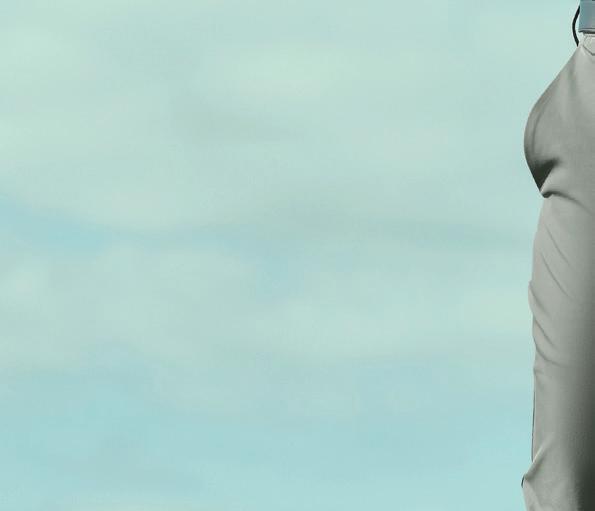
2024 SCRAMBLING PERCENTAGE (RANKED 1ST ON PGA TOUR)





HARRY GRIMSHAW
SIX YEARS AFTER HIS RUNNER-UP FINISH AT ROYAL PORTRUSH, TOMMY FLEETWOOD RETURNS TO THE NORTHERN IRISH COAST FOR ANOTHER SHOT AT OPEN GLORY BY
SIX YEARS AGO, TOMMY FLEETWOOD
walked up the 18th fairway on Sunday afternoon of The 148th Open at Royal Portrush, finishing in the closest position he has ever been to hoisting the Claret Jug. He’d gone toe-to-toe with Shane Lowry in the final group — but it wasn’t to be for the Englishman.
Now, The Open is heading back to the Northern Irish coast, and Fleetwood returns with both the memories and motivation to perhaps have one more chance at golf’s grandest prize.
“It means a lot,” Fleetwood says, reflecting on that Sunday in 2019. “It’s mad to think that was six years ago now.
“I think it’s easy to look back at coming so close, but of course it didn’t quite happen. That was Shane’s week 100%.”
He isn’t wrong. Lowry’s fairytale win in front of a roaring home crowd has become part of Open folklore. But Tommy’s performance — and the charm with which he handled the disappointment — has left its own lasting impression.
“The best consolation is how well Shane did and played,” Tommy said at the time. “It hurts... but I finished six shots back and it feels closer. It was Shane’s time, Shane’s week. Fair play.
“I played well early on, but the margins... the putts on one, two, and three, I scrambled a bit, and missed a short one on 10. It was nice to still be in The Open with six or seven holes to go,” he said after the round. “But the mountain was too high to climb.”
Fleetwood’s solo second-place finish remains his best result at The Open.
“I had such a special time there,” he says. “I still look at that Open at Portrush and remember playing in the final group on Sunday and being that close to achieving a lifelong dream.”
“I look at it with so many fond memories... you have to take all the positives from what happened then, and take them into now and be prepared for it and look forward to it.”
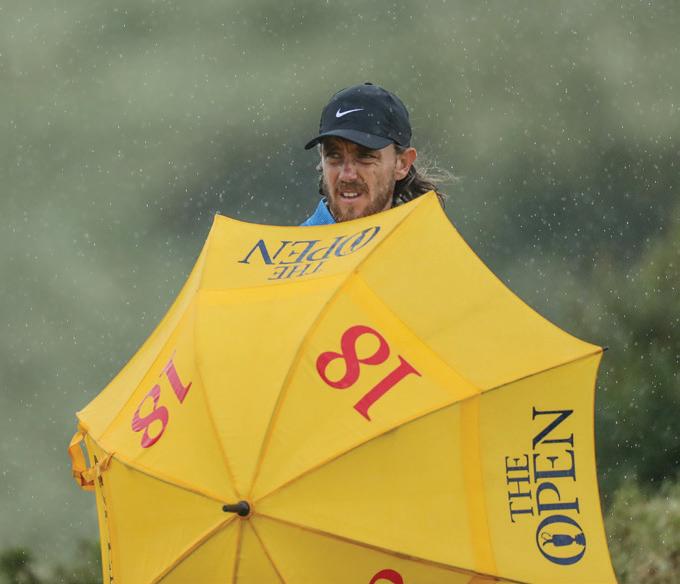
I STILL LOOK AT THAT OPEN AT PORTRUSH, AND BEING THAT CLOSE TO ACHIEVING A LIFELONG DREAM.
Fleetwood has come a long way since that week. Three further wins on the DP World Tour has taken his total to seven, a second Ryder Cup victory, a silver medal in the Olympics at Paris 2024 and now a DP World Global Ambassador, plus he’s also put down roots in Dubai with his family — where he set up the Tommy Fleetwood Academy at Jumeirah Golf Estates.
Tommy is one of golf’s ‘good guys’ and a fan favourite for many, but that major moment — and a Claret Jug — remains a glaring omission from an otherwise stellar résumé for himself.
This summer’s return to Royal Portrush is shaping up to be historic. The 153rd Open, running from 13–20 July, will welcome a record-breaking 278,000 fans — the largest Open ever staged outside of St Andrews. Demand was so high that over one million ticket applications were submitted in the ballot last year.
TOMMY’S TIME?
Fleetwood’s solo secondplace finish in 2019 at Royal Portrush remains his best result at The Open.
In addition, it will be the biggest sporting event Northern Ireland has ever hosted, with an estimated £213 million economic impact, according to research from Sheffield Hallam University’s Sport Industry Research Centre.
For Fleetwood, with a familiar course and a crowd he knows will be electric, it’s an opportunity he is relishing.
“I think the crowds are going to be amazing,” he says. “It’s an amazing golf course and an amazing tournament. So I’m very excited.”
As The Open Championship returns to Royal Portrush, Tommy Fleetwood knows his opportunity is there.
BY LIAM JAMES

As the final men’s major of the year approaches, preparations are in full swing — and while I’ve been racking up the air miles between the PGA and DP World Tours, our base here at JA The Resort in Dubai has played a big role in keeping things consistent this summer. With a few of the players I look after also living out here, we’ve been able to put in some really solid work during the off weeks.
That balance is important. Players are constantly on the move — different continents, courses, and time zones — so having a familiar place to train and reset has been invaluable. Everything we’ve done in the lead-up has been built around the upcoming Genesis Scottish Open and The Open, and for those still trying to qualify, the next few weeks are absolutely crucial.
Thorbjørn Olesen is the only player I work with who’s currently exempt for The Open, having qualified through last season’s DP World Tour Race to Dubai Rankings. But there’s real optimism in the group. Johannes Veerman, Jorge
A SPECIAL WEEK
The history, the atmosphere, the way it captures the full personality of the game — there’s nothing quite like it.
Campillo, Richard Mansell, and David Micheluzzi are all entered into Final Qualifying on 1st July, and others are eyeing the remaining spots through the qualifying series events. The door’s still open, and we’re preparing like it is.
When it comes to The Open, it’s always a special week — not just for the players, but for us coaches too. Growing up watching The Open, it’s the kind of event you dream about being part of in any capacity. The history, the atmosphere, the way it captures the full personality of the game — there’s nothing quite like it. Even now, I always make a conscious effort to take it all in. These are the moments you feel genuinely grateful for.

This year’s venue, Royal Portrush, brings back some brilliant memories. I was there in 2019, working with Matt Wallace during the week Shane Lowry went on to lift the Claret Jug. Matt was paired with Tiger Woods for the first two rounds, which — as you can imagine — was something pretty unforgettable to witness firsthand. You never quite forget the roar of a Tiger crowd, especially at an Open.
When it comes to Portrush itself, it’s a spectacular venue. It’s not just a great test of golf; it’s one of the most stunning places The Open visits. The design, the natural layout, the atmosphere — it all adds up to a very unique challenge. And like any Open venue, the real defences come from the course and the conditions working together. You’ve got the wind, the rough, the rain — and often all three in the space of a few holes.
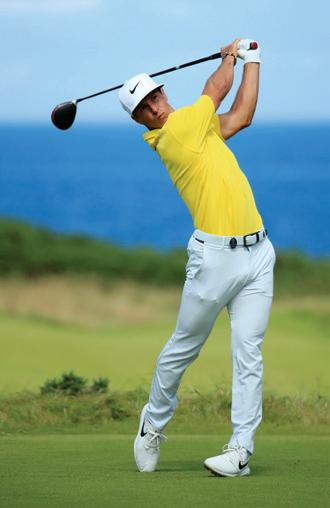

There are several standout holes at Portrush. The 5th, for instance, runs along the coast and becomes a completely different beast in a crosswind. The 14th has a tough blind tee shot that requires real trust, and the 16th — a par 5 — has a well-protected green that can make or break momentum. What I love about this place is that no hole feels easy. Every shot asks a question, and every mistake can cost you. That’s the essence of The Open.
In terms of preparation, I tend to leave the detailed course strategy to the player and their caddie — that’s their team dynamic. But I always walk the course in practice rounds to understand the layout and get a feel for where the real challenges lie. From a coaching perspective, it’s about preparing the player with the tools and confidence to adapt. If a player isn’t fully comfortable on a certain tee shot or with a particular shape in the wind, that’s where we come in — finding solutions, simplifying decision-making, and building belief in the plan.
One of the most overlooked aspects of links golf is patience. You can hit a perfect shot and end up in trouble, or get a lucky bounce from a poor one. That randomness is part of the charm, but it also requires a certain mindset. The ability to absorb frustration and stick to your game plan is often what separates the contenders from the rest. That’s something we talk about a lot during prep.
So as The Open draws near, there’s plenty of hard work still to be done — but also a real sense of excitement, it’s infectious! It’s a privilege to be part of that environment, and I’ll never take that for granted.






Former gang member and convict Ryan Peake has qualified for The Open but wants to be known for more

BY JOEL BEALL









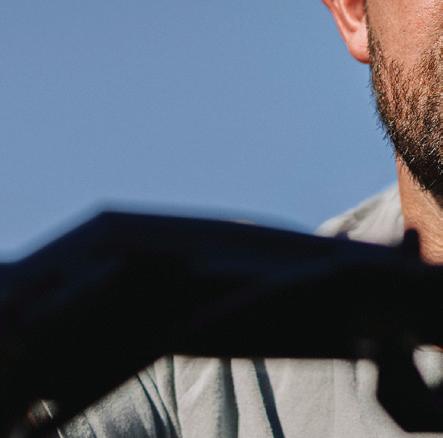

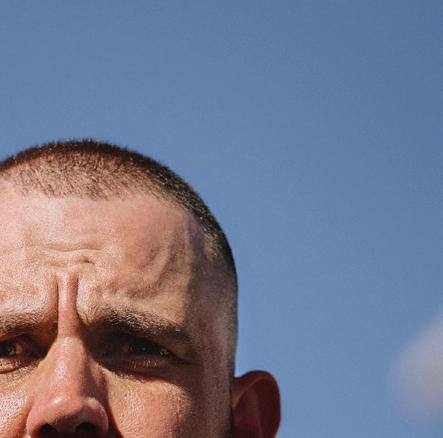




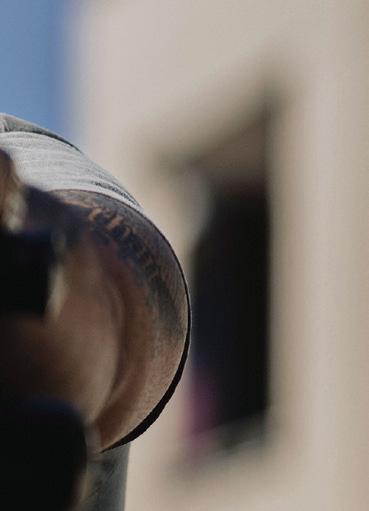
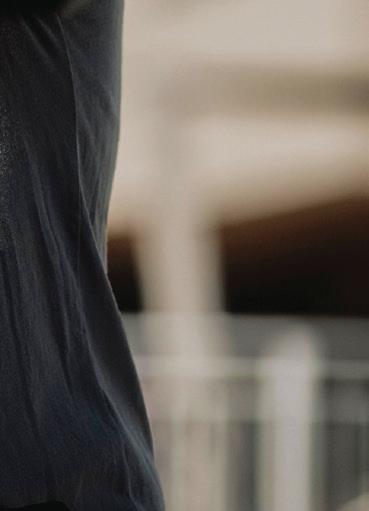
When the ball disappeared, Ryan Peake’s arms went up, and a primal roar came out—an explosive release after many hard years questioning if this moment would ever come.
Before teeing off in the final round of the 2025 New Zealand Open, Peake, 31, had received encouraging calls from his coach Ritchie Smith and PGA Tour player Min Woo Lee, both assuring him he was “already a winner” regardless of the outcome, but Peake had journeyed too far for mere moral victories.
The significance lay not entirely in the win nor its rewards, like a DP World Tour card and a spot at the Open Championship at Royal Portrush. That made eight-footer allowed Ryan Peake to finally outrun the shadows of his past.
A DECADE EARLIER, PEAKE CONVINCED HIMSELF prison was the natural evolution of his choices, privately relishing how it might elevate his street cred. With shoulders that strained doorframes and fists that could rewrite futures, he says the physical threats of incarceration hardly registered. Besides, his gang’s presence inside promised protection in numbers. Yet on day one of his five-year sentence, the system dismantled Peake with bureaucratic precision—first through the ritual humiliation of a shower where guards catalogued his nakedness with clinical indifference, then draped his once-intimidating frame in fatigues so oversized that the fabric engulfed his massive wrists, like a child swallowed by his father’s wardrobe in a parody of manhood.
Many prisoners spend their first week in crisis care for suicide prevention, but Peake, then 21, entered general population where his fellow bikers, or “bikies,” operated. The guards marched him to a 16-square-foot cinderblock cell that reeked of its previous occupant, the floor littered with trampled debris nobody had bothered to clear. Dinner was served through a slot—a tinfoil-wrapped disappointment containing rice and what Peake would later describe as “the tiniest bit of chicken I’d ever seen.” The delivering guard






said, “Enjoy it because it’s the best meal we’ve got this week.” Perched on the edge of a mattress the compression of which held the stories of others, Peake cradled the foil plate as his gaze climbed to the lone object on the wall, a cracked mirror colored with graffiti. The fractured reflection bore little resemblance to the man who was once one of his country’s most promising golfers.
The florescent lights went out on a timer as the cell plunged into darkness. Peake didn’t sleep much that first night, a single thought encircling his mind: “What the hell have I gotten myself into?”
STORIES ABOUT RYAN PEAKE EVOKE COMPARISONS TO folk heroes. “Ryan was always a precocious talent,” says Bevan Dagg, captain of Lakelands Country Club in Perth, Australia. “He filled in one day for a seniors interclub match at 12. He beat someone 8 and 7.”

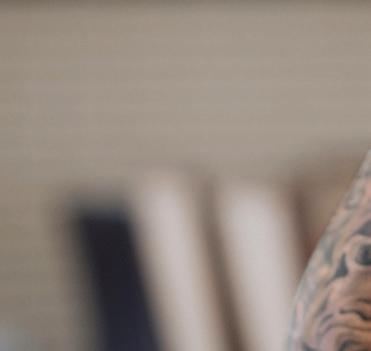



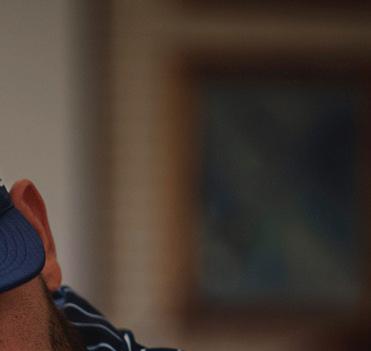

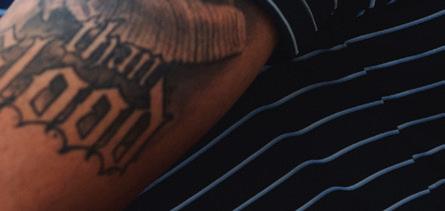

“We were playing an Australian Interstate series event at Royal Perth Golf Club,” says 2022 Open champion Cameron Smith.
“Peake rocked up with a big, wide brim hat with corks on it and a fly screen because there were so many flies. He played in it all day.”
“We’re having a practice round for an Australian amateur event at Hartfield Club,” says coach Ritchie Smith. “We’re throwing balls everywhere, in bad lies, getting a feel for the greens. Maybe you’ll see a chip in or two over a practice round. That day, Peaky had 14.”
Ryan Peake is the son of a bricklayer who transitioned to greenkeeping after masonry wrecked his body. His father and grandfather played golf on the weekends, and when young Ryan asked to join them, his first few swings left them transfixed. “It was easy. Felt like a natural talent,” Ryan

remembers. “Everyone was looking at each other going, ‘Oh, he’s pretty good,’ and I enjoyed it.” By his 10th birthday, Ryan had his own clubs and had begun lessons at Lakelands. Within a few years, his bedroom shelves bowed under the weight of trophies.
Despite lacking discipline during practice sessions, Peake’s talent was sufficient for junior golf. He generated astonishing power with a quick, compact swing—imagine a left-handed Jon Rahm merged with a lumberjack’s swipe. He played with abandon, prioritising spectacular, improbable shots over course management, and thrived on competitive pressure. He was distinguished by both his physical prowess and an inclination to not defer to golf’s stuffier traditions.
“As a teacher, you care for all your students, But, boy, I loved Peakey because so many golfers … they are all sort of the same,” Ritchie says. “Peakey? He was his ownself, treated everyone great, the most lovable guy. Some of the kids
“It’s a tough life, being a bikie. I think they saw an opportunity for one of their own to better themselves.”




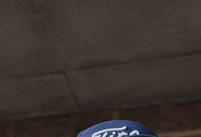







coming up act like golf is a job and shut people out. Peakey never let golf get in the way of humanity.”
By his early teens, Peake was dominating prestigious tournaments and representing Australia alongside Cameron Smith in junior team competitions. At 17, he competed as an amateur in the Australian Open, and just a year later, impressively finished 10th at the PGA Tour Australia’s WA Open. Despite these triumphs, Peake struggled with golf’s inherent solitude. Though Lakelands provided a semblance of community where his talent earned him recognition, the age gap with most members left him adrift. He battled depression. To this day, he can’t explain its catalyst, only its presence. Lacking peer socialisation, Peake says he stood out among classmates with his adult-like demeanor and was a target for bullying at school. The harassment grew so severe that his father routinely escorted him home. When he finally retaliated against his chief tormentor, the teasing ceased—but the depression persisted.
“Life’s hard,” Peake says, both looking at his past and present. “Seems like nothing ever goes right—and when things do start to go right, there’s always something that’s going to start to go wrong.”
During his teenage years, Peake began frequenting neighborhood gatherings where he observed the fierce brotherhood among street crews. What captivated him wasn’t their revelry but their solidarity—a stark contrast to the seclusion of golf.
On paper, the Rebels motorcycle gang presents itself as a fraternity. Its constitution describes a non-profit devoted to Harley-Davidson enthusiasts who embrace freedom, counter-cultural values and brotherhood. However, Australian authorities have implicated several of its members in the past of criminal activity, including weapons distribution and assaults.
On weekends, Peake would spend time in their man-cave garages filled with cars and bikes, pool tables and punching bags. Repeatedly, he probed about membership possibilities only to be dismissed with amusement. “Just enjoy being part of the clubhouse furniture,” they told him.


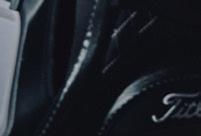
SAFE SPACE
Peake learned the game at Lakelands C.C. in Perth, Australia.
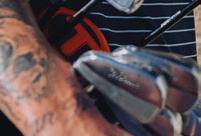





“I wasn’t letting anyone in the golf scene understand what scene I was into on the outside,” Peake says. “I wouldn’t even go out with my parents because I didn’t know who I was going to bump into. That’s when it became all so tiring … I just lived two lives, you know?”
Peake turned professional in 2012 at age 19—a gambit born from the belief that financial stakes might ignite purpose. Instead, it extinguished what little flame remained. His combination of raw talent and audacity supported by lackadaisical practice habits didn’t translate in the professional ranks. Though he survived cuts on Australian mini-tours, meaningful success eluded him. His depression deepened in a sport defined by its psychological rigors and inconsistent rhythms. Later that season, his competitive nadir arrived at Australasia Tour Q-School— an experience Peake describes as “the loneliest week of my existence”—when he failed to make the cut at Victoria’s Peninsula Golf Club. Upon returning home to Western Australia, he drove to the practice facility and stayed in his vehicle for 30 minutes, psychologically incapable of stepping onto the



grounds. When he finally summoned the strength to pop the trunk, a realisation jarred him: his clubs were missing, and more disturbingly, in the haze of his depression he had no idea where he left them. Golf had once been his release from the world, and now it had become another weight. “That’s when I knew it was over,” Peake says.
Peake was crushed by his failure of those who had invested in him—his parents, coach, and the Lakelands members whose support now felt like an unbearable weight. His once-athletic 200-pound frame ballooned toward 300, a physical manifestation of his internal collapse. He ricocheted between manual labour jobs— working in mines, plastering walls, laying bricks and mixing concrete.
Amid the wreckage of his former aspirations, one light emerged. The Rebels’ leadership had relented, and at age 21, Peake received his full patch signifying membership. “Where I was at that stage in my life, it was the only thing that brought me comfort,” Peake says. “I felt like I belonged.”
Peake acknowledges the stigma surrounding the Rebels. He doesn’t defend every action in the club’s history but insists it bears little resemblance to Hollywood portrayals of biker gangs. He refuses to criticise those who sheltered him during his darkest hours, but he pauses, contemplating that pivotal decision to join and its consequences.
“My life had fallen into depression. I lost all self-esteem. I didn’t know who I was, lost all direction in my life. What happened … I can’t say it was just one night, one mistake. It was years of build-up.”
PEAKE WAS NEVER ONE TO BACK DOWN FROM A FIGHT. But two years into his Rebels membership, in November 2014, he found himself in far more than he’d bargained for.
Peake alleges that a person in his neighborhood made a threat to the Rebels. Peake and his friends were at a barbecue when they heard the man was home. “I will be honest with you, mate, we went over to have a conversation, to let him know if he didn’t knock it off, he was going to get punches to the head. That sounds harsh, but this person lived the same lifestyle as us, and the only way you can get through is to speak that language.” Peake and his associates approached the man’s residence when suddenly the garage


to push his game to new Bryson DeChambeau continues to push his game to new

door ascended. According to Peake, the man reached for a “brown object” tucked into his waistband. Peake delivered a preemptive kick, after which his companions joined the assault, one wielding a baseball bat. The confrontation resulted in multiple severe injuries to the man, including fractures to both arms and skull. (The victim did not respond to interview attempts made by Golf Digest, and his name is redacted from the public record for this case.)
Weeks later while working at the golf course, Peake spotted three unmarked police cars in the parking lot and knew they had come for him. Peake surrendered, concerned they might have forcibly entered his parents’ home searching for him. In the holding cell, he encountered a police officer he recognised—a former junior golf competitor. The officer gave Peake a look of disappointment and said, “What are you doing here?”
Peake received a five-year prison sentence for assault. He implicated one else in the crime.
Hakea is an overcrowded maximum-security prison. A 2024 inspection conducted by the Australian Health Inspector concluded it had one of the worst conditions in the country: excessive confinement periods, inadequate access to fresh air, single-occupancy cells housing two inmates, restricted availability of showers and clean attire, infestation of cockroaches and rodents—conditions characterised as “cruel, inhuman, or degrading.” The facility has elevated rates of self-harm and suicide among its population.
His first week, Peake approached a corrections officer to request transfer to another cell. Unaware of the hierarchical deference expected from inmates toward prison staff, Peake responded to the guard’s derision with choice words. This transgression marked his first collision with the dynamics governing prison life. “The next day, I was in the shower, and suddenly I had 20 officers surrounding me,” Peake says. They dragged him to the detention unit, with nothing in the cell but a piece of paper and pen for the prisoner to write an apology note.
For his first year, Peake refused his mother’s visits to Hakea, unwilling to expose her to its harsh realities. His father couldn’t be held back. “I could see the disappointment in his eyes,” Peake says, “just wondering how his son went from a golfer to this.”
As hard as those visits were, they were also an inflection point. Rather than just play cards, Peake committed to becoming someone his parents could be proud of upon release. He disciplined himself physically, shedding accumulated weight. To change the prospect of more manual labour, he pursued studies for electrical certification. To his fellow inmates who were interested, he offered crude golf instruction in their limited time outdoors. He wrote letters of apology, including one to Ritchie Smith expressing remorse for squandering his talent.
Time moves slowly inside, Peake says. His focus was on stacking days together until they became weeks, and weeks until they became months. In 2017, two-and-ahalf years into his sentence, the prison televisions broadcast Cameron Smith claiming the Australian PGA Championship. When some inmates discovered this was Peake’s friend and former teammate, they needled him about resuming his career upon release. Peake
At age 17, Peake was competing on national stages.
dismissed this with a laugh. Perhaps he’d play socially again, but the pro dream was dead.
Shortly after, Peake received an unexpected letter containing only Ritchie Smith’s name and contact information.
“I’ve made some bad phone calls in my life, but this was the most nervous I’ve ever been,” Peake says. “He’s one of the best coaches in the world, and I’m just some bikie in jail … But as soon as I heard his voice, I was calm. He’s the most chilled-out person in the world.”
“I had lost touch with Peakey after he left golf and didn’t know what happened to him,” Ritchie says. “That’s not the person I knew. I called because I was genuinely worried about him. He’s a good kid. He just messed up.”
They started speaking regularly. Peake talked about trying to learn a trade for when he got out, but Ritchie had another suggestion. “I said, ‘What about giving golf another go?’ I felt like this guy needed something to look forward to, something where he could be his best self.”
Peake was interested, but first he had to make things right with the Rebels.
Membership in an outlaw motorcycle club is understood as a lifelong commitment. Those attempting to leave have faced violent repercussions and worse. Peake felt confident that his closest supporters would back him, but knew there were others in the hierarchy who would need to be persuaded. Peake determined that if Ritchie Smith—famous for coaching Minjee Lee to two major wins—still recognised potential in him, the effort was justified. He requested a formal meeting with Rebels leadership inside the prison. “I said, ‘I know this sounds stupid, but this coach teaches some of the topranked golfers in the world, and he thinks I can still make it as a professional. I want to take this path.’ I was worried because I didn’t want them to think I was disloyal, but I felt like I owed it to all the people around me, and myself, to try.”
To his surprise, he never received so many handshakes and hugs in one sitting. His youth might have had something to do with it, or maybe the Rebels saw what Ritchie saw. “It’s a tough life, being a bikie,” Peake says. “I think they saw an opportunity for one of their own to better themselves. They were all telling me this could be my last chance. Go earn it.”
Having maintained a good disciplinary record, Peake petitioned for relocation to a minimum-security facility for the final year of his sentence, which was approved. Geared toward reacclimating prisoners to work, Peake would be allowed as much as 12 hours outside the prison under supervision. He could hit balls, visit home and simultaneously undergo rehabilitation for a shoulder injury.
“I was up front, let him know what we are facing,” Ritchie says. “Making it as a pro, this is 1,000-to-1 shot. But if you’re willing to give it a try, so am I.”
PEAKE HADN’T PLAYED FOR SOME TIME BEFORE HIS arrest, so when Ritchie accompanied him to a driving range session during his first week of release, Peake hadn’t struck a golf ball in six years. Though his swing appeared rusty, Ritchie was unconcerned. “His skill was never golf. He was so natural, I knew that would come back,” Ritchie says. “We were more worried about the mental side of things, reintroducing him to competition.” Within the first three months of the program, Peake returned to Lakelands for a club tournament. With family in attendance, he delivered a bo-
“I didn’t know how to be a person. The only way I can explain it is, I felt like everyone was a sheep and I was a lion.”


gey-free 66. Despite the bittersweet necessity of returning to confinement after delivering a brief winner’s speech— “Enjoy your night, boys. I’m going back to prison”—the experience provided further motivation.
“To that point, my only real confidence came from Ritchie. Like, he’s not going to waste his time on me if I’m a charity case; he’s too busy for that. He could have made a call to make sure I was OK in jail and be done with it,” Peake says. “But that 66, it was the first time I thought, Hey, maybe I’m not completely lost.”
When he was released from prison in May 2019, Peake returned to Lakelands to work on the greenkeeping staff. Ritchie brought him around his other students, feeling they could help fill the void of belonging Peake had experienced with the Rebels. Soon Peake was holding his own against players with Australian tour cards. “He was getting under par pretty easily,” Ritchie says. “My main concern was making sure it was a joy. That’s how the burnout started in the first place. The game will come in time. Let’s just make sure he’s having fun doing it.”
Meanwhile, Peake’s transition to life beyond prison walls continued. Incarceration had imposed a rigid structure— designated times for showering, meals, recreation and sleep. His regained liberty brought the paralysis of choice.
“I was freaking out. So much had changed in five years. Everyone had a cell phone now in Australia. I’d get lost because roads were different. I’d go to the grocery trying to order food to make a chicken and salad. There were like 50 different brands, plus free-range, organic. It used to be just a five-dollar pack. I’d buy a can of tuna because it was easier. I didn’t know how to be a person. The only way I explain it is, I felt like everyone was a sheep and I was a lion.”
Though those in Peake’s orbit had witnessed transformation.
“Ryan had a much clearer perspective on life and a genuine desire to make better choices. He was grateful to be given a second chance,” says his mum, Michelle. He began a relationship with a woman named Lee. While his golf prowess resurged, he progressed from local competitions to mini-tour events, with Ritchie observing remarkable ad-

















Peake cashed $335,000 NZD for his win at the 2025 New Zealnd Open.

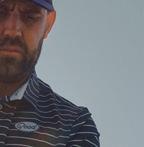

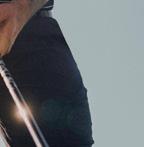

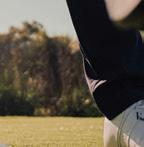











vancement at six-month intervals. Though his technique remained somewhat unrefined, his dedication to practice intensified, and his formidable power persisted undiminished.
Ritchie was impressed with Peake’s psychological resilience. “He exhibited no fear of [poor] performance. Having confronted true darkness in life, a golf tournament loses its intimidation factor.”
Peake acquired a van and traversed Queensland, competing in every available tournament while supplementing his income with occasional temporary employment. By 2023, he secured partial status on the Challenger PGA Tour of Australasia before earning full playing privileges for the 2024’25 season. Several near victories preceded his journey to the New Zealand Open.
That life-changing week began in jeopardy. Peake’s criminal record trapped him in immigration limbo in Australia for hours, threatening both his tournament entry and his plan to propose to Lee during the trip. “I was standing there with my backpack on with a ring in it, thinking, Well, this isn’t going to happen this trip, either,” Peake recalls. Finally cleared, he reached the Millbrook Resort late Tuesday, squeezing in just one practice round before the competition began. After a Friday 64 put him in contention, he took Lee on a helicopter ride that evening and proposed. She said yes.
While Lee had to go home early, she was Peake’s first call after the triumph. He quips he’s grateful he proposed when he did: “I might’ve had to spend a little bit more money on the ring.”
Peake still squirms when discussing the New Zealand Open. He harbors no illusions about its standing in golf’s hierarchy—while it attracts decent talent, the field depth pales against truly premier tournaments. His discomfort intensifies given his subsequent performance; in his blunt assessment, “I haven’t broken many eggs” since that victory. Yet in rare, quiet moments, Peake allows himself to contemplate that win, and not for its material rewards.
“Deep down, my biggest worry was running out of time,” Peake says. “I started to know I was good enough to do it. I just didn’t know if I’d get the chances to prove it.”
PEAKE ACKNOWLEDGES HIS PREVIOUS TRAJECTORY toward self-destruction. While recognising the compelling nature of his narrative, he understands its distinctiveness stems from misjudgments, and the exceptional golf he now plays cannot erase the anguish he inflicted upon those who love him. While he isn’t exactly remorseful about the violence that put him in jail, he is about the decisions that led to it. “I get why people reach out that are struggling in life now, but to be honest, it’s not really something that I can help them with. I’ve still got my own struggles,” Peake says. “It’s cool to see I give someone hope, but at the moment, I’m still trying to find my feet and get myself back out there.”
Those around him have seen him do the little things. A lifelong member at Lakelands was fighting cancer, and the end was near. The week he passed, Peake visited him for three hours and gifted him the 18th green flag from the New Zealand Open.
“Ryan deserves to be seen for the person he is today,” says his father, Mel, “dedicated, resilient and ready to make a meaningful impact in the golf world.”
If the idea of playing in the Open hasn’t really settled for him, Cameron Smith explains it might be because Peake’s worried that he will be a distraction. “He still hasn’t come around to the idea that he is one of the boys,” Smith says. “He doesn’t realise he’s such a good bloke that everyone will want to be around him.”
Peake recognises the opportunity before him. Among all major championships, the Open holds particular significance in his dreams because links golf is the closest to the type of golf he plays in Australia. Still he remains adamant that this achievement does not become the culmination of his story. “If this is where it ends,” Peake says, “I’ll merely be remembered as the former outlaw biker who competed at Portrush.”
Peake’s goal is clear—to be known for who he is rather than who he was.









































